Disclaimer
Asher Brown Durand
American Hudson River School Artist
1796 - 1886
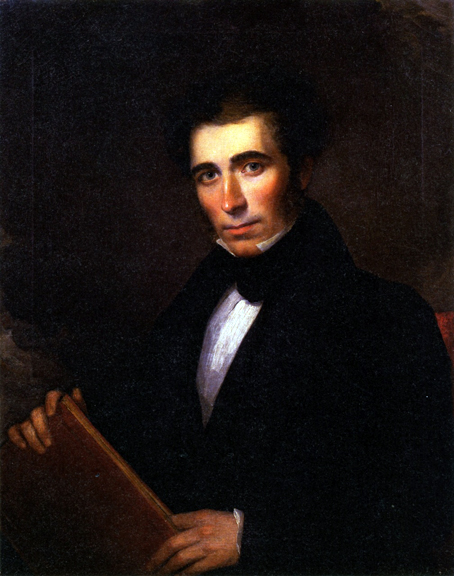
Self-Portrait:1835
Durand was born in and eventually died in Maplewood, New Jersey (then called Jefferson Village), the eighth of eleven children; his father was a watchmaker and a silversmith.
Durand was apprenticed to an engraver from 1812 to 1817 and later entered into a partnership with the owner of the firm, who asked him to run the firm's New York branch. He engraved the Declaration of Independence for John Trumbull in 1823, which established Durand's reputation as one of the country's finest engravers. Durand helped organize the New York Drawing Association in 1825, which would become the National Academy of Design; he would serve the organization as president from 1845 to 1861.
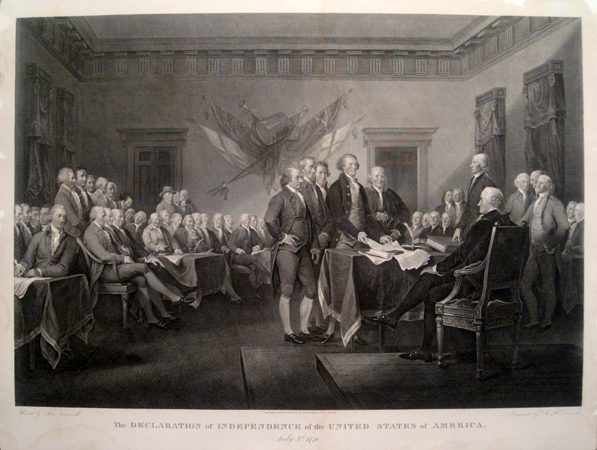
Asher Durand's Engraving of John Trumbull's Painting
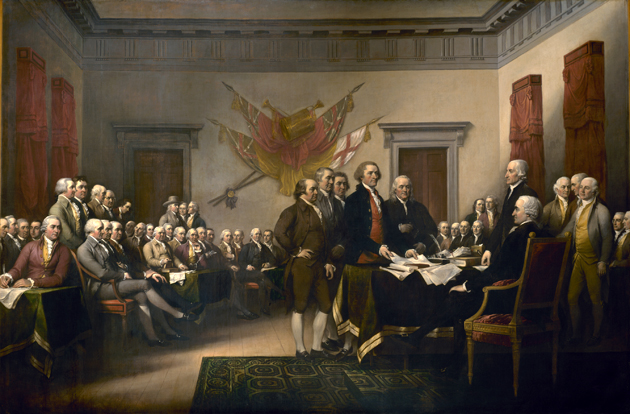
John Trumbull's Painting of the Signing of the Declaration Independence
His interest shifted from engraving to oil painting around 1830 with the encouragement of his patron, Luman Reed. In 1837, he accompanied his friend Thomas Cole on a sketching expedition to Schroon Lake in the Adirondacks and soon after he began to concentrate on landscape painting. He spent summers sketching in the Catskills, Adirondacks, and the White Mountains of New Hampshire, making hundreds of drawings and oil sketches that were later incorporated into finished academy pieces which helped to define the Hudson River School.
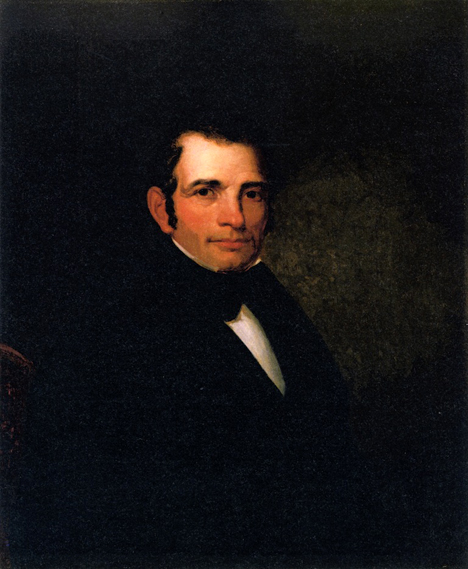
Luman Reed: 1844
One of early America's great art patrons, the dry goods merchant Luman Reed of New York offered critical support to the careers of Durand, the landscape painter Thomas Cole, and the genre painter William Sidney Mount, and built a gallery in his house for the display of their work and that of the old masters. From Durand, Reed commissioned portraits of the nation's presidents and eventually encouraged the artist to abandon his original career as an engraver to become a painter. Still, he would not live to see Durand blossom as a landscape artist. Reed died untimely, just the year after the completion of this solid likeness. His passing was sorely mourned; Durand reminded Cole in a letter that Reed was "the man whose equal we shall never see again." The artist did not exaggerate, but Reed's partner, Jonathan Sturges, for whom this portrait was painted, became an important patron in his own right of Durand, Cole, and their colleagues.
Quoted From: Heilbrunn Timeline of Art History - The Metropolitan Museum
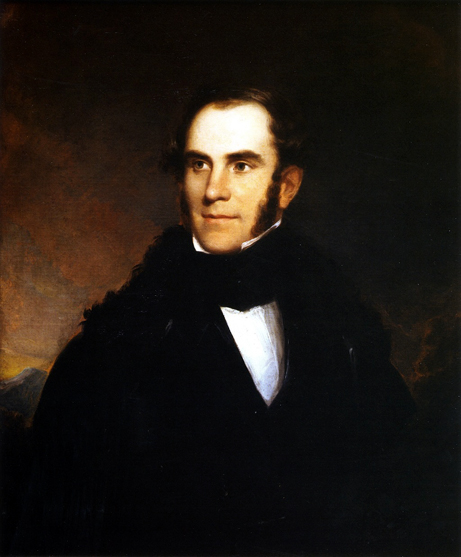
Thomas Cole: ca 1837
Durand is particularly remembered for his detailed portrayals of trees, rocks, and foliage. He was an advocate for drawing directly from nature with as much realism as possible. Durand wrote, "Let (the artist) scrupulously accept whatever (nature) presents him until he shall, in a degree, have become intimate with her infinity...never let him profane her sacredness by a willful departure from truth."
Like other Hudson River School artists, Durand also believed that nature was an ineffable manifestation of God. He expressed this sentiment and his general views on art in his "Letters on Landscape Painting" in The Crayon, a mid-19th century New York art periodical. Wrote Durand, "[T]he true province of Landscape Art is the representation of the work of God in the visible creation..."
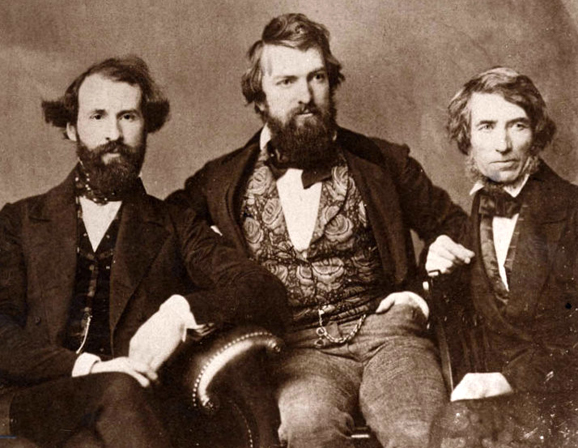
Pictured L to R.: Henry Kirke Brown, Henry Peters Gray and Asher Brown Durand,
photographer unknown. Artists were members of the National Academy of Design: 1850
Durand is noted for his 1849 painting Kindred Spirits which shows fellow Hudson River School artist Thomas Cole and poet William Cullen Bryant in a Catskills landscape. This was painted as a tribute to Cole upon his death in 1848. The painting, donated by Bryant's daughter Julia to the New York Public Library in 1904, was sold by the library through Sotheby's at an auction in May 2005 to Alice Walton for a purported $35 million. The sale was conducted as a sealed, first bid auction, so the actual sales price is not known. At $35 million, however, it would be a record price paid for an American painting at the time.
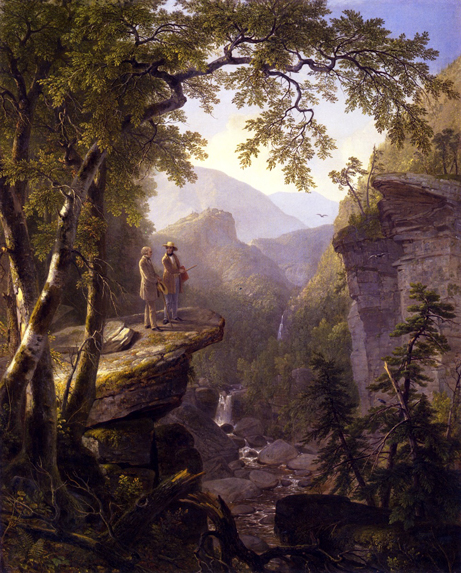
Kindred Spirits: 1849
Another of Durand's painting is his 1853 Progress, commissioned by a railroad executive. The landscape depicts America's progress, from a state of nature (on the left, where Native Americans look on), towards the right, where there are roads, telegraph wires, a canal, warehouses, railroads, and steamboats.
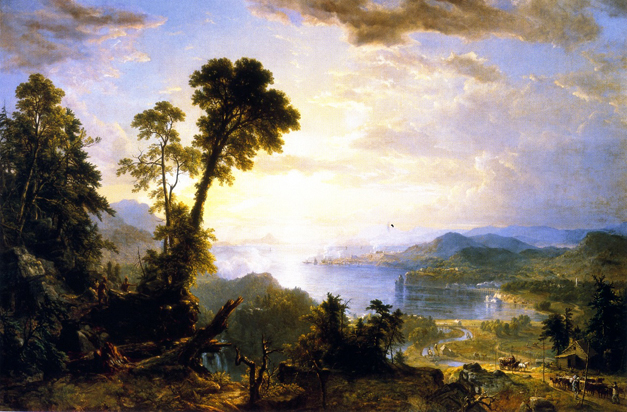
Progress: The Advance of Civilization: 1853
Two American Treasures, Sold - Hudson River School
This is an interesting story about the sale of two significant pieces of American Art. Yet, I am not sure how I feel about this. ~ Senex
In 2007, the Brooklyn Museum exhibited nearly sixty of Durand's works in the first monographic exhibition devoted to the painter in more than thirty-five years. The show, entitled "Kindred Spirits: Asher B. Durand and the American Landscape," was on view from March 30 to July 29, 2007.
Quoted From: Asher Brown Durand - Wikipedia
Heilbrunn Timeline of Art History - The Metropolitan Museum of Art
The acknowledged dean of American landscape painters following the death of Thomas Cole, Asher Brown Durand exemplified the fresh ideal of naturalism for the second-generation painters that came to be called the Hudson River School. Born in Jefferson Village (now Maplewood), New Jersey, Durand first worked for his father, a watchmaker and silversmith, before apprenticing with the engraver Peter Maverick in Newark, from 1812 to 1817. In the latter year, he became Maverick's associate and established and led the firm's New York City branch until 1820, when he left following a dispute with Maverick over Durand's independent acceptance of a commission from John Trumbull to engrave his famous painting, The Declaration of Independence (1786; Yale University Art Gallery). Completed in 1823, the engraving significantly boosted Durand's standing in the New York art world, and in 1825 he joined with Samuel F. B. Morse, Thomas Cole, William Sydney Mount, and others in founding the New-York Drawing Association, soon to be called the National Academy of Design; shortly after, he was elected to the Lunch Club, ancestor of the Bread and Cheese Club, the Sketch Club, and the Century Association. Under the influence of his fellow artists, Durand in the 1830s turned more and more to painting, producing genre and portraits. The latter included a series of the American presidents commissioned by the liberal New York dry-goods merchant Luman Reed, who by 1835 had persuaded Durand to abandon engraving.
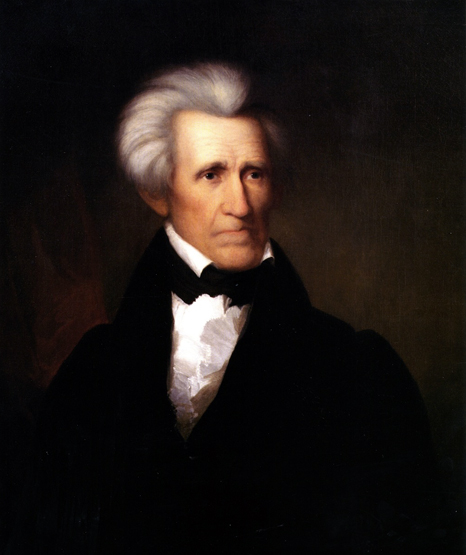
Andrew Jackson: 1836

James Madison: 1833
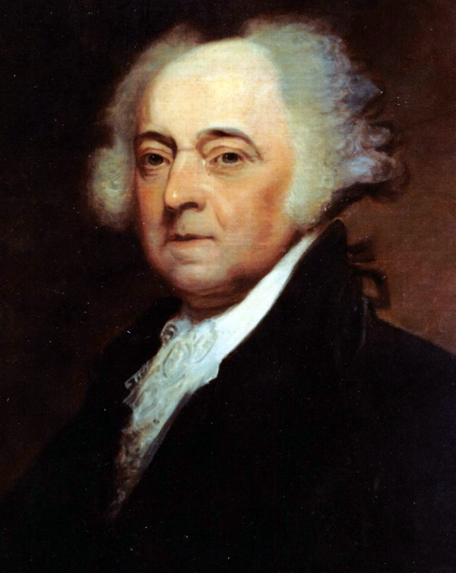
John Adams

John Quincy Adams
Reed was also an enthusiastic patron of Mount and Cole, and the latter's talent, ideals, and success as a landscape painter increasingly attracted Durand, who was among the first New Yorkers in 1825 to buy a Cole painting. The two eventually became fast friends and, as early as 1837, sketching companions in the Adirondacks and, in 1839, in New England. The earlier jaunt probably was pivotal in converting Durand to landscape painting; however, he had begun exhibiting the occasional landscape subject at the Academy a decade earlier. Durand's commitment to his new artistic career was reflected in his first and only journey abroad, from April 1840 to June 1841, visiting Britain, France, Belgium, Holland, Germany, Switzerland, and, from October 1840 to the following May, Italy, from the lake district as far south as Naples. With him on part of the journey were two younger aspiring painters who had also started in the engraving trade, John Frederick Kensett and John William Casilear.
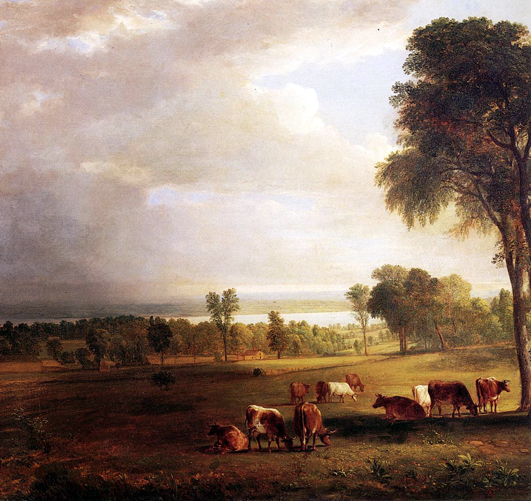
Gathering Storm: ca 1837
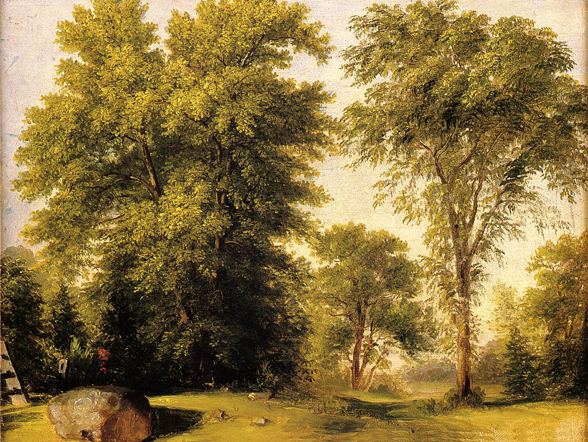
Study from Nature, Hoboken, N. J. ca 1837

Landscape Composition: ca 1838
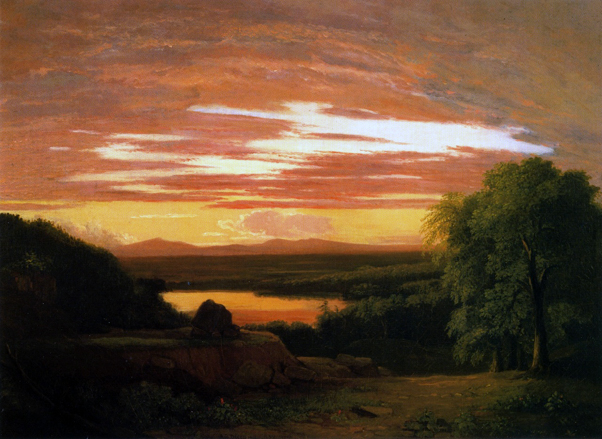
Landscape - Sunset: 1838
Though Durand copied the old masters extensively in the galleries of Europe and drew frequently outdoors, his most critical encounter abroad may have been in London, where the American expatriate Charles Robert Leslie showed him, Kensett, and Casilear paintings and plein-air oil sketches by the late British master John Constable, for whose estate Leslie was the executor. To one Constable painting, Durand responded that it evinced "more of simple truth and naturalness than any English landscape I have ever before met with." On his return home, Durand seemed to take Constable's naturalism to heart, fortifying his conviction by reading Leslie's 1843 biography of the English master as well as the first volume, also published in 1843, of British critic John Ruskin's Modern Painters. Durand began making seasonal trips in the hills along the Hudson River, then in the Adirondacks and New England-often with other artists or with his family-to sketch in pencil and oil directly from mostly near-at-hand natural motifs. From these, he fashioned progressively vivid compositions typically of woodland interiors, culminating in masterpieces of organic verisimilitude, such as the Museum's In the Woods, 1855. In the same year, Durand cemented his reputation as the guiding philosopher of the second generation of New York landscape painters with the publication in nine periodical installments of his "Letters on Landscape Painting." In these, he ardently promoted the practice of painting outdoors from humble natural objects as the route to learning and refining one's art as opposed to learning from other art or artists. Concurrently, Durand functioned as the personal exemplar to several of the younger painters who gathered about him in a veritable summer sketching colony in the White Mountains.
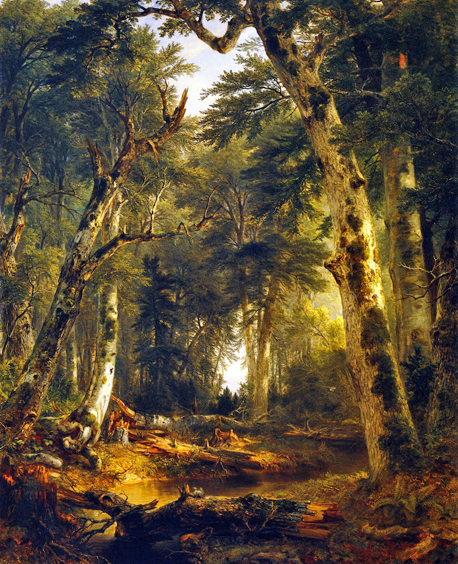
In the Woods: 1855
In the Woods is not only arguably the masterpiece of Durand's career as a landscape painter but, executed a decade later than the Museum's Beeches, measures the artist's striking advance in the naturalistic ideals he set for himself following his travel to Europe in 1840–41. Admiring the works of John Constable on that journey, Durand recognized the critical importance of plein-air sketching in imparting a sense of natural verisimilitude to his studio paintings. In the late 1840s, moreover, the English critic John Ruskin's prescriptions of "truth to nature" only fortified Durand's aesthetic standard, honing both his perceptual and technical skills outdoors and in the studio, and expanding the appeal chiefly of his woodland scenes beyond the visual to the tactile: his sylvan surfaces of bark, lichen, and moss beg the sense of touch as well as of sight. At the same time, his compositions of converging, weathered trees, their leafage filtering celestial light, evoke the idealism of Durand's friend, the poet William Cullen Bryant, who in his "Forest Hymn" had asserted, "The groves were God's first temples."
Quoted From: Asher B. Durand: In the Woods-Metropolitan Museum of Art
By 1855, Durand had also been president of the National Academy of Design for a decade and would remain so until the beginning of the Civil War, testimony not only to his personal qualities but to the preeminence to which landscape had risen by the mid-nineteenth century. The mantle of leadership he had inherited from Cole, who died in 1848, is exemplified in the commission he received the following year to portray Cole and Bryant together in the Catskills in what may be the most renowned of Hudson River School paintings, Kindred Spirits (1849; Crystal Bridges Museum of American Art, Bentonville, Arkansas, on loan to The Metropolitan Museum of Art), executed in commemoration of Bryant's eulogy to Cole at his death. Durand never paid greater tribute to his inspiration, yet evidence in his 1840s correspondence with Cole, since 1836 living in Catskill, reveals evolving differences between them of aesthetic philosophy; envy on Cole's part of his acolyte's rising success in New York; and a corresponding degree of estrangement left unresolved at Cole's demise. In his "Letters on Landscape Painting," then, Durand acknowledged Cole's originating contribution to American landscape painting but stressed the need to advance it beyond him.

Kindred Spirits: 1849
Kindred Spirits (1849) is a painting by Asher Brown Durand, who was part of the Hudson River School. It depicts the painter Thomas Cole, who had died in 1848, and his friend, poet William Cullen Bryant, in the Catskill Mountains. The landscape painting, which combines geographical features in Kaaterskill Clove and a minuscule depiction of Kaaterskill Falls, is not a literal depiction of American geography. Rather, it is an idealized memory of Cole's discovery of the region more than twenty years prior, his friendship with Bryant, and his ideas towards American Nature.
Quoted From: Kindred Spirits - Wikipedia
Despite his fervent espousal of naturalism in landscape art, Durand failed to pursue it consistently, and many of the paintings of his long maturity-scrupulously executed as most are-reflect more conventional landscape modes based on seventeenth- and eighteenth-century French and Dutch antecedents. Critical acclaim declined accordingly, especially as younger painters such as Frederic Church and Albert Bierstadt pushed the thresholds of both subject and technique with vast frontier landscapes of South America, the Arctic, and the West. However, even after Durand's retirement in 1869 to his native Maplewood, he was scarcely forgotten. In 1872, he was feted at home by twenty of his former colleagues from the National Academy, and his work continued to appear at such venues as the Centennial Exhibition in Philadelphia. About 1879, in his ninth decade, Durand painted his last picture, seven years before his death.
Kevin J. Avery
Department of American Paintings and Sculpture, The Metropolitan Museum of Art
Quoted From: Asher Brown Durand (1796-1886), Thematic Essay - Heilbrunn Timeline of Art History - The Metropolitan Museum of Art
Various Works of Art of Asher Brown Durand
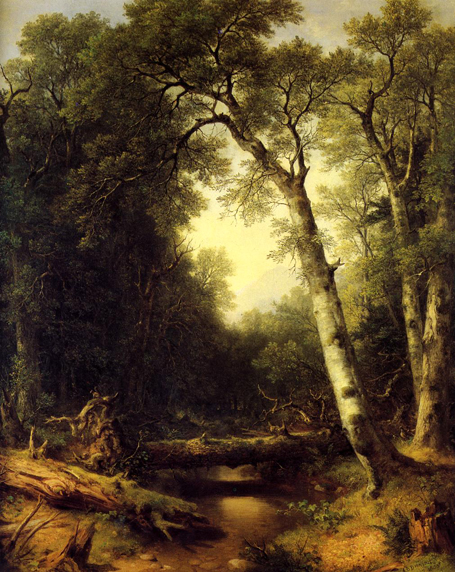
A Creek in the Woods: 1865
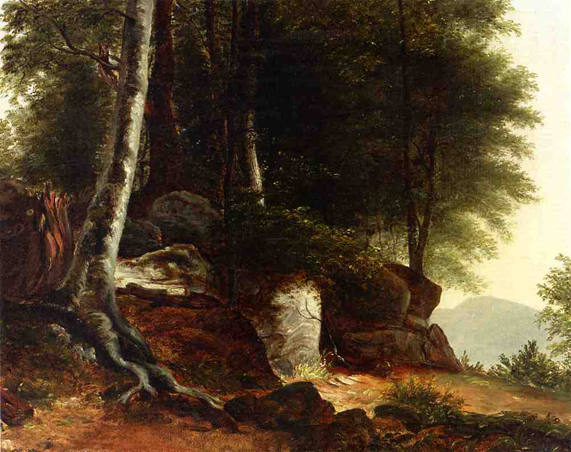
A Study from Nature: ca 1845
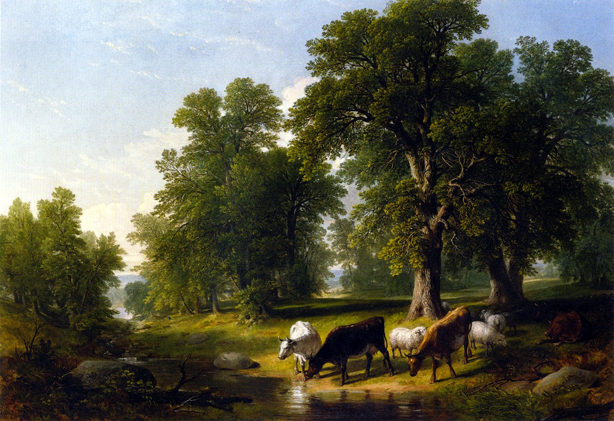
A Summer Afternoon: 1849
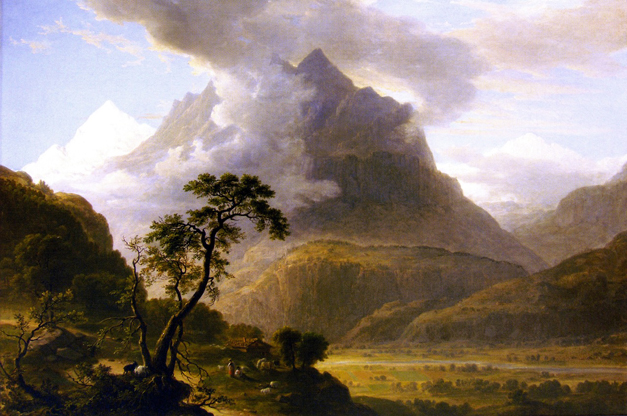
Alpine View, near Meyringen: 1842
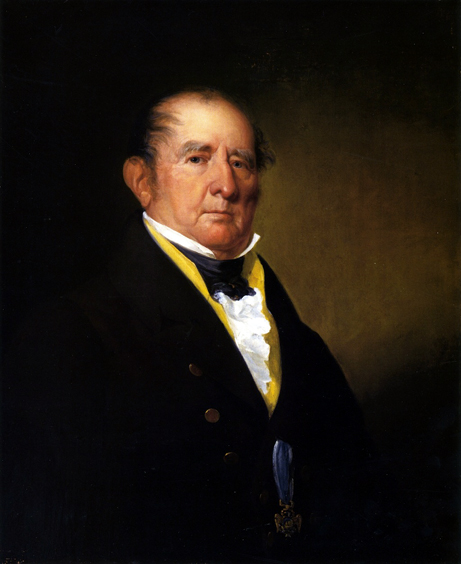
Aaron Ogden: 1833
After the war, Ogden studied law and was admitted to the bar in 1784. He commenced practice in Elizabeth. He served as a presidential elector in the 1796 Electoral College that elected John Adams. He was clerk of Essex County from 1785-1803, and was elected as a Federalist to the United States Senate to fill the vacancy caused by the resignation of James Schureman and served from February 28, 1801, to March 4, 1803. He lost his bid for reelection to the Senate in 1802. In 1803, Ogden was elected to the New Jersey General Assembly, where he served until 1812. Ogden was elected trustee of the College of New Jersey (later to become Princeton University) in 1803, a post in which he served until his death. Ogden was elected as Governor of New Jersey in 1812.
Ogden was nominated by President James Madison as major general of the Army in 1813, but declined the appointment. He became engaged in steamboat navigation in 1813, and was a defendant in the Gibbons v. Ogden case that denied New York State's attempted monopoly on steamboat operation between New York and New Jersey. Ogden moved to Jersey City in 1829 and resumed the practice of law. In 1830, he was appointed as collector of customs and served until his death in Jersey City. Ogden's body is interred at the First Presbyterian Church Burial Ground in Elizabeth.
Quoted From: Aaron Ogden - Wikipedia
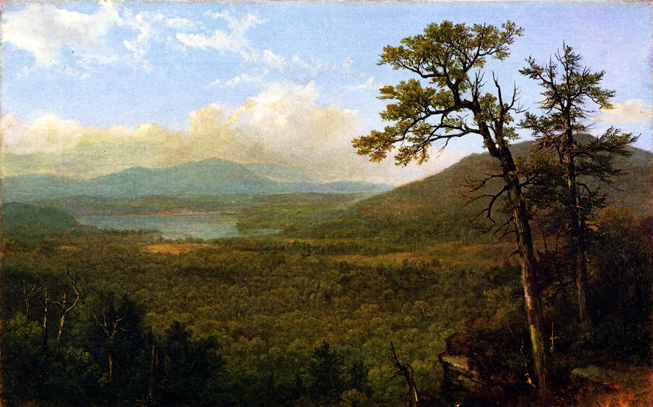
Adirondack Mountains, New York: ca 1870
"Heeding the Call of Nature: Asher Brown Durand's Communion with the American Landscape"

Adirondacks: 1848

After a Summer Shower: Date Unknow
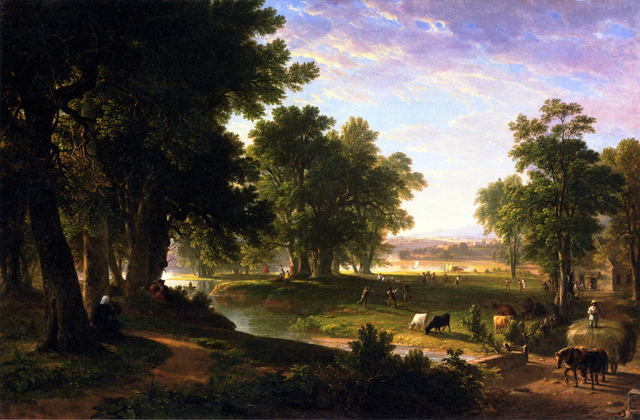
An Old Man's Reminiscences: 1845
This painting is one of Durand's most richly symbolic landscapes. Relying on the English poet Oliver Goldsmith's Deserted Village of 1770, which recounted the visit of an old man to the site of the town where he had spent his youth, Durand's painting functions as a cohesive picture of scenery, but more properly as a landscape of memory. What the old man sees reminds him of his own past. Childhood is represented by the schoolchildren, youth by the lovers seated beneath a tree, and adulthood by the man driving the hay cart.
Quoted From: An Old Man's Reminiscences - Albany Institute of History and Art
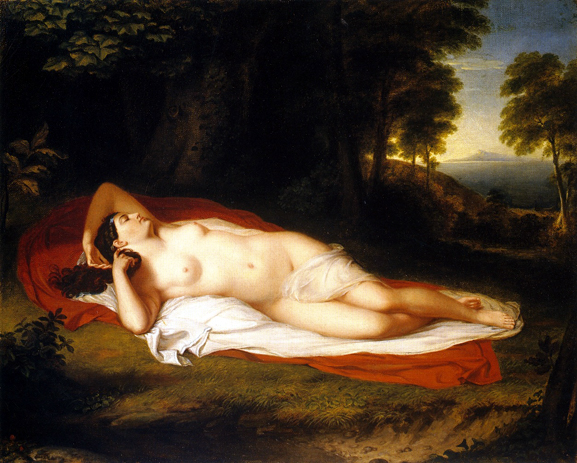
Ariadne: ca 1831-35
Durand painted this exquisite copy of John Vanderlyn's Ariadne Asleep on the Island of Naxos (1809-12; Pennsylvania Academy of the Fine Arts) as the model for his engraving of virtually the same size, published in 1835. Ariadne was the daughter of the king of Crete who helped the Greek hero Theseus escape the labyrinth, then was seduced and abandoned by him on the island of Naxos. Vanderlyn had chosen the subject of his original as a premise for painting a lifesize nude, the finest example of such in the early history of American art. However, the original was painted in Paris, the center of Neoclassicism, where nudity in art was practically the standard. Not so in the young republic of America, where Vanderlyn's exhibitions of the painting were controversial and the artist could find an interested buyer only in Durand, who had little more success selling his reproduction.
Quoted From: Asher B. Durand's Ariadne - The Metropolitan Museum
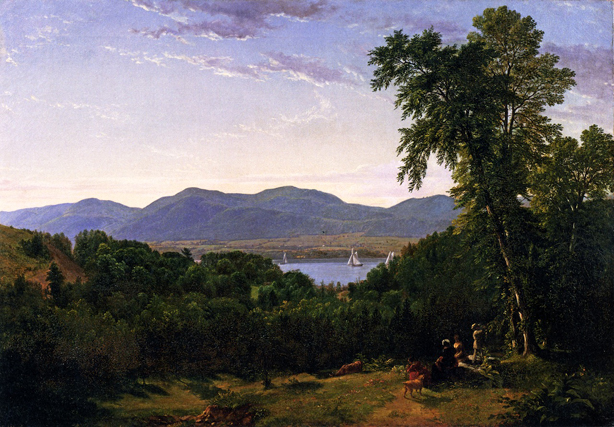
Beacon Hills on the Hudson River: ca 1852
This painting is closely related in subject, composition, and style to Durand's Fishkill Mountains, New York, signed and dated 1856, owned by the Peabody Institute of the City of Baltimore. The Society's study probably dates to the same year.
Quoted From: Beacon Hills on the Hudson River | New-York Historical Society
The Hudson River School and the Idea of Recreation | Behind The Scenes

Black Birches, Catskill Mountains: 1860
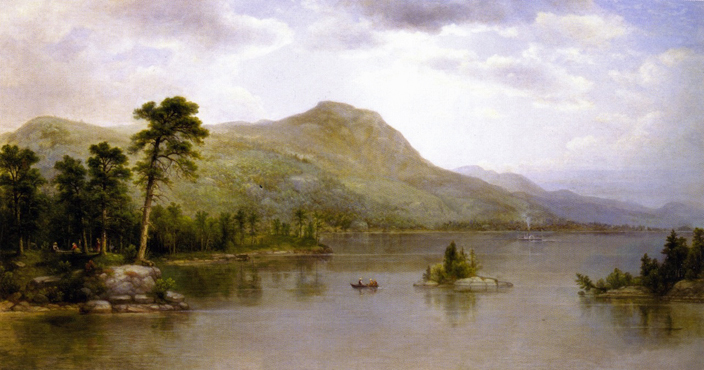
Black Mountains, from the Harbor Islands, Lake George: ca 1875

Butternut Tree at Hague, Lake George, New York: ca 1862
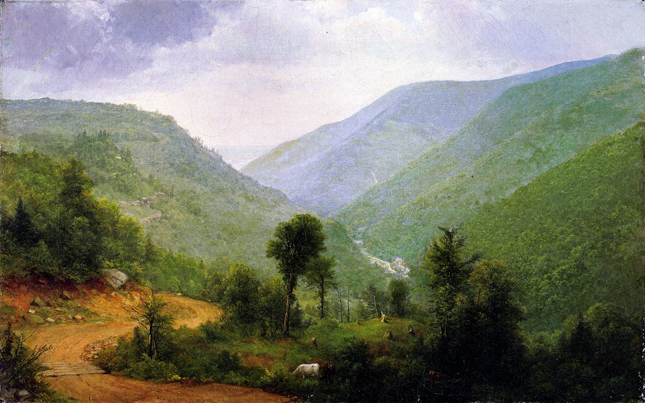
Catskill Clove, New York: 1864
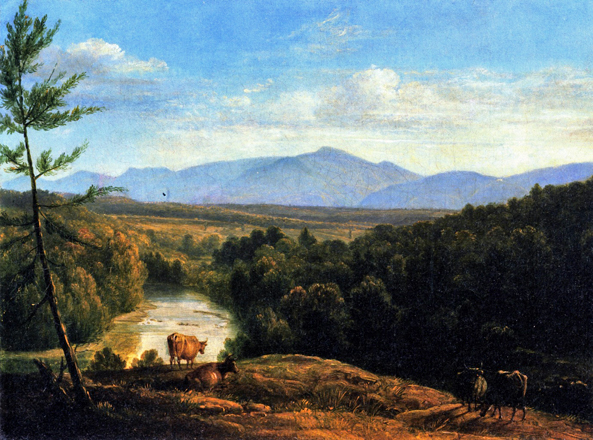
Catskill Mountains: ca 1830
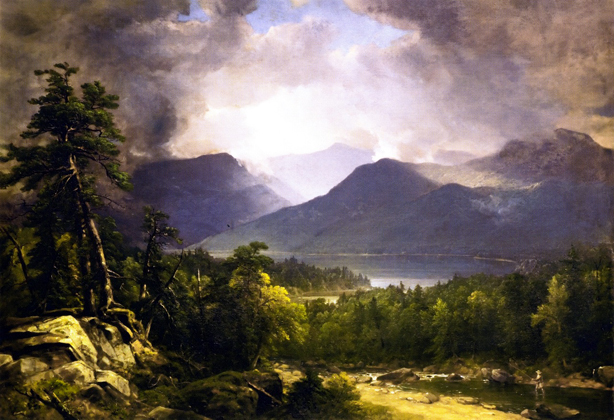
Clearing Up: 1854
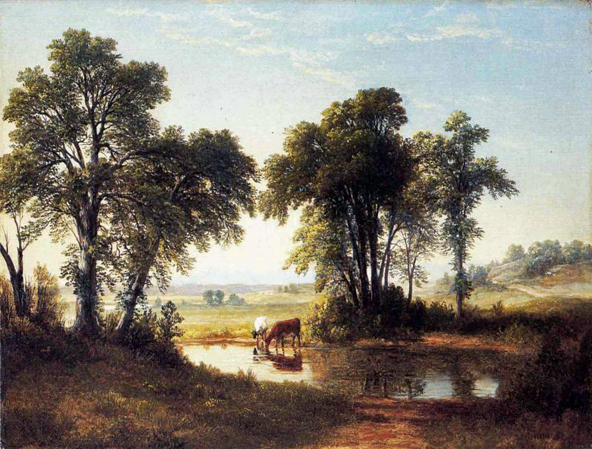
Cows in a New Hampshire Landscape: Date Unknown
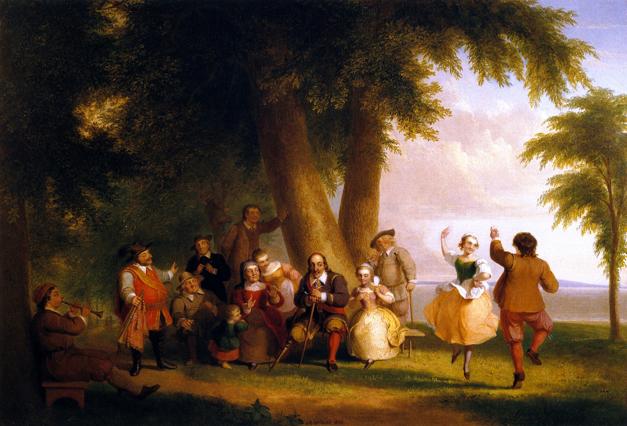
Dance on the Battery in the Presence of Peter Stuyvesant: 1838
Peter Stuyvesant
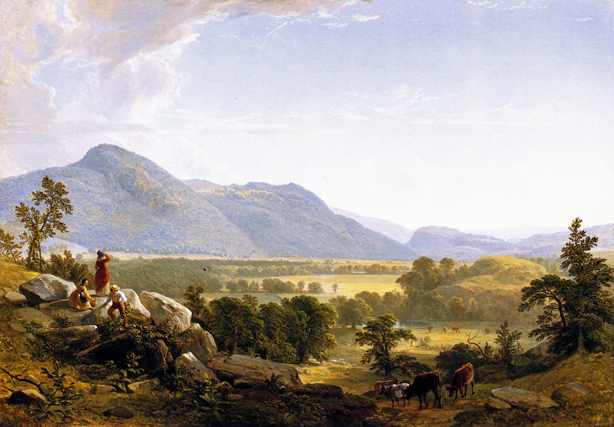
Dover Plain, Dutchess County, New York: 1848
In this gently lit, pastoral landscape, cows graze near a party of berry-pickers who have climbed a cluster of boulders. The panoramic view reveals distant fields, cultivated and bounded by rows of trees and forested areas. The standing figure, surveying the calm and peaceful vista, represents the optimistic future for the citizenry at mid-century.
Quoted From: Treasures to Go - Young America
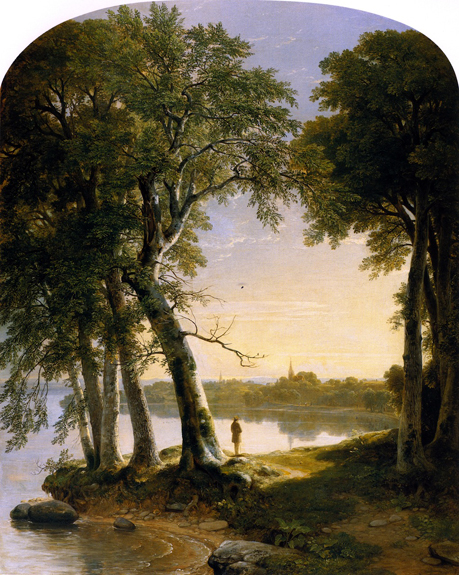
Early Morning at Cold Spring: 1850
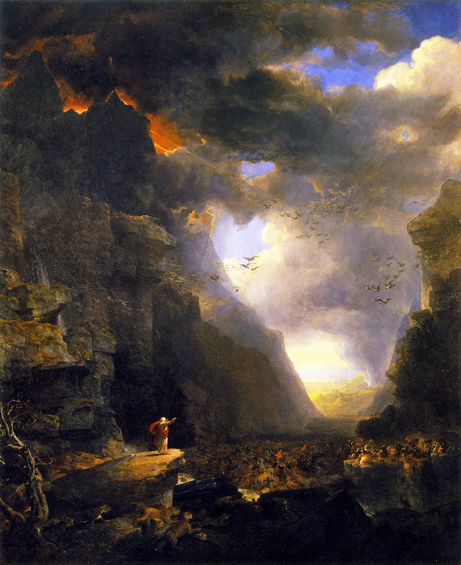
Gods Judgment Upon Gog: ca 1851-52
Tales from the Easel: Nineteenth- and Twentieth-Century American Narrative Paintings, circa 1800-1950
An Essay by Dr. Charles Eldredge
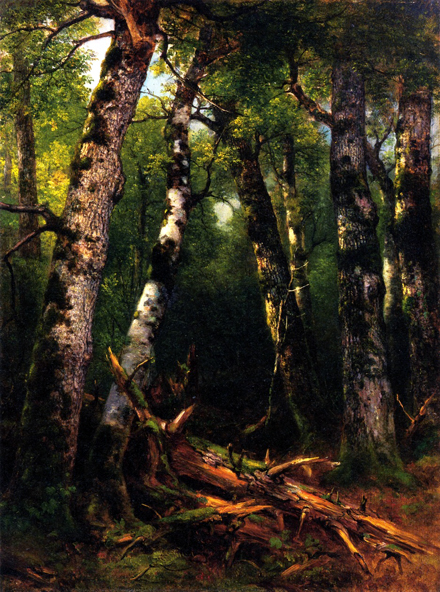
Group of Trees: 1855-57

Guard House, Catskill Mountains: ca 1850-57
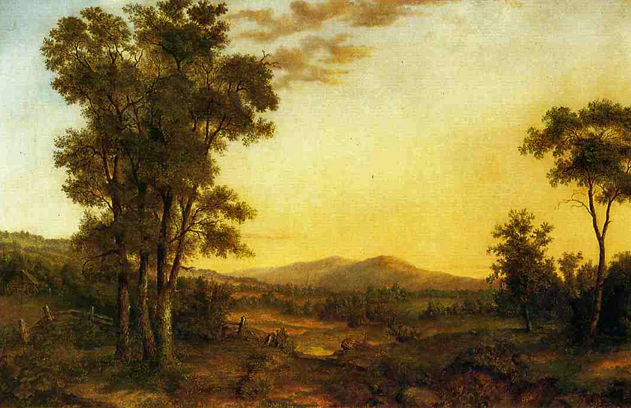
Hudson River Landscape: Date Unknown
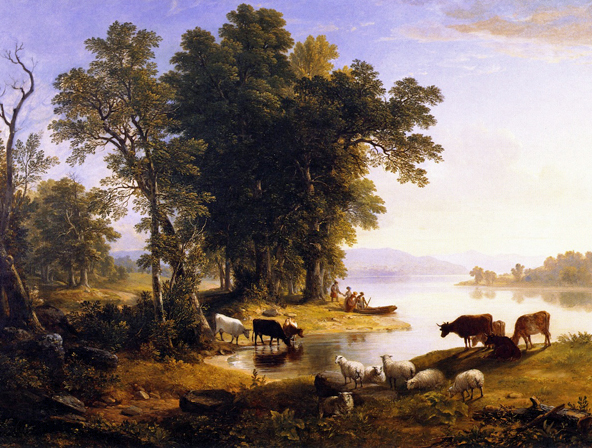
Hudson River Looking toward the Catskills: 1847
This painting is rendered on an unusually large scale and shows people fitting into a beautiful and benevolent environment. The graceful forms of the trees seem to offer protection to the participants and lead the eye of the viewer to the picturesque range of the Catskills. The foreground shows highly detailed studies of the local plant life. A friend of both Thomas Cole and James Fenimore Cooper, Asher B. Durand was a leader of the Hudson River School. A successful engraver, portrait and genre painter, Durand and several other artists traveled to Europe in 1840 to develop their skills as landscapists. On his return to the United States, Durand won immediate acceptance as an established talent. This painting is a magnificent example of Durand's landscape style shortly after his return from Europe.
Quoted From: Fenimore Art Museum | Hudson River Looking Toward the Catskills
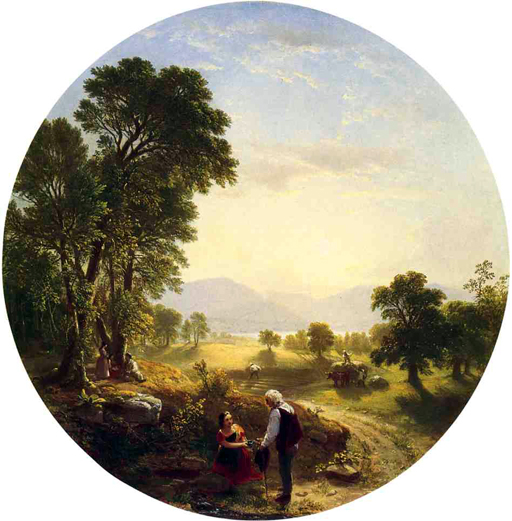
Hudson River Scene: 1846
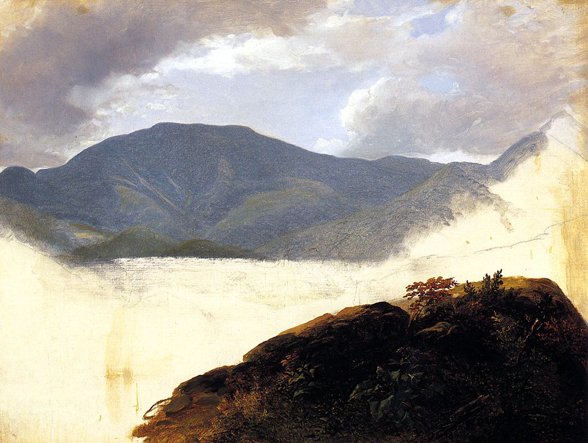
Hudson River Sketch: ca 1850-57
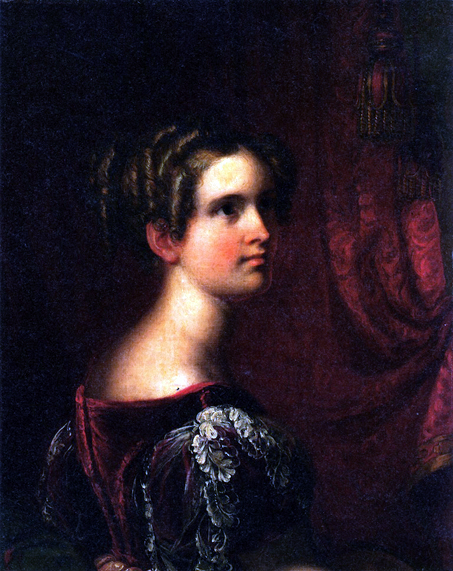
Ideal Head: A Suggestion from Life - 1836
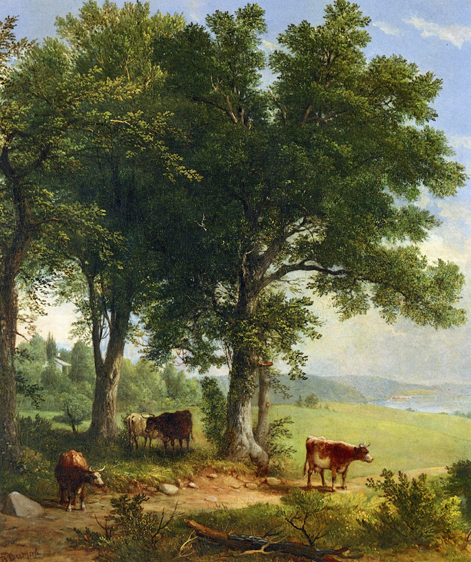
In the Shade of the Old Oak Tree: Date Unknown
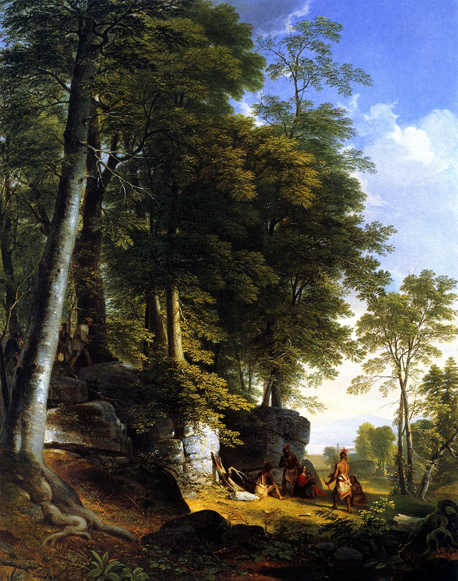
Indian Rescue: 1846
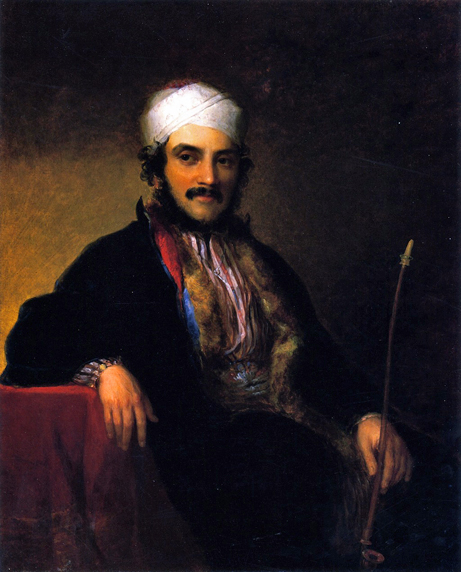
Isaac Edrehi of Morocco: 1840
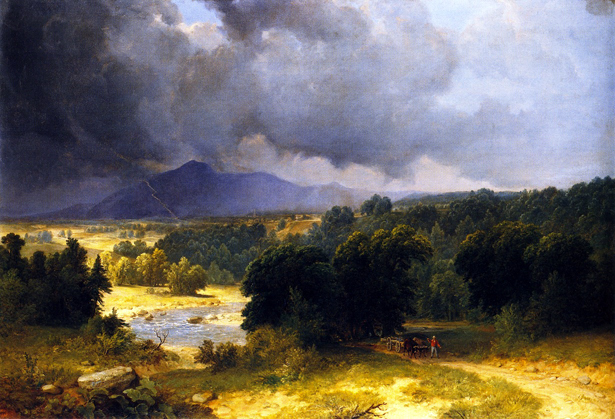
June Shower: 1854
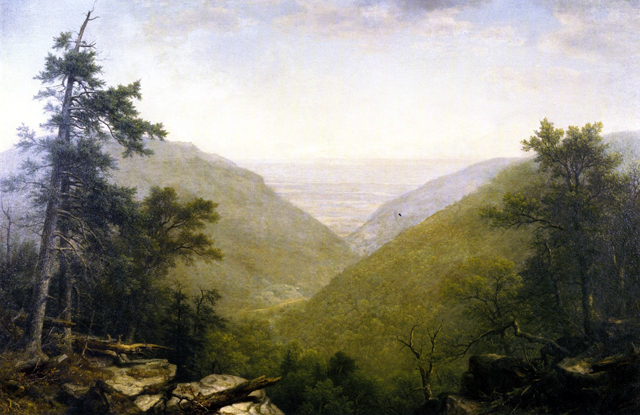
Kaaterskill Clove: 1866
The clove, a distinctive feature or "cleft" in the Catskills, was one of the places most painted by the Hudson River School artists. The rugged terrain of the clove was created by glacial action and the erosive forces of the streams that cut into its depths and cascade down its sides. Palenville, at the foot of the clove, became America's first art colony.
Thomas Cole painted the clove from the top of Haines Falls, Asher Durand from nearby Santa Cruz Falls, and Sanford Gifford from near Poet's Ledge. Their paintings helped Americans form a sense of national identity. Here was a quality of nature wild, sublime, and distinctly different from anything known in Europe. The clove was of such importance to these painters that Durand chose it as the setting for the painting Kindred Spirits, his tribute to Thomas Cole with poet William Cullen Bryant. The area today is largely as it was in the 19th century due to its inclusion in the Catskill Forest Preserve.
"The peculiar fidelity and sentiment of nature with which Durand always depicts trees, is eloquently manifest. The aerial perspective, the gradations of light, the tints of foliage, the slope of the mountains - in a word, the whole scenic expression is harmonious, grand, tender and true." Henry T. Tuckerman, Book of the Artists; American Artist Life, 1867
Quoted From: HRSAT: Kaaterskill Clove
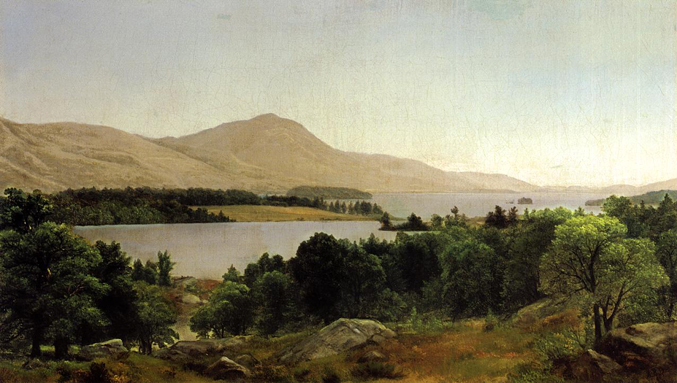
Lake George: Date Unknown

Lake Scene in the Mountains: 1874
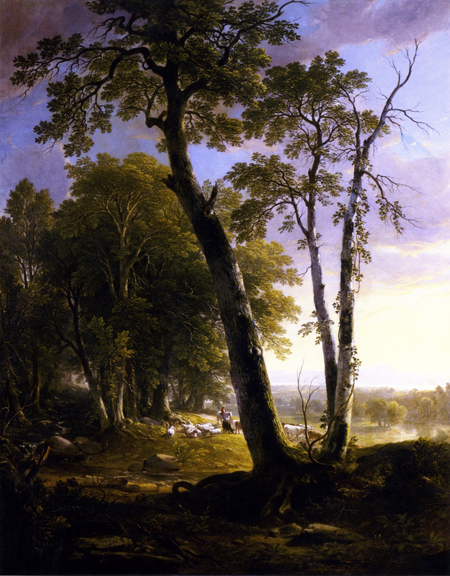
Landscape, Composition, Afternoon, In the Woods: 1847
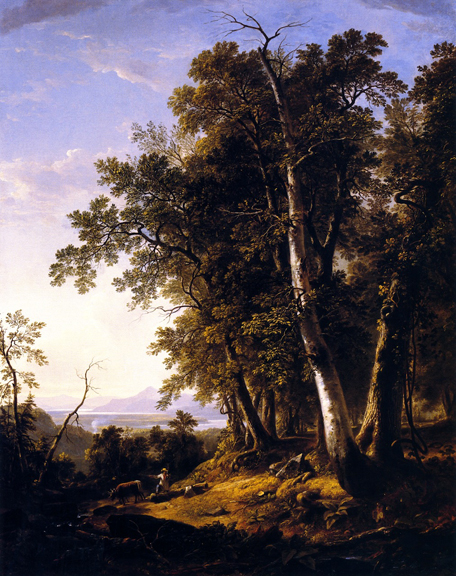
Landscape, Composition, Forenoon: 1847
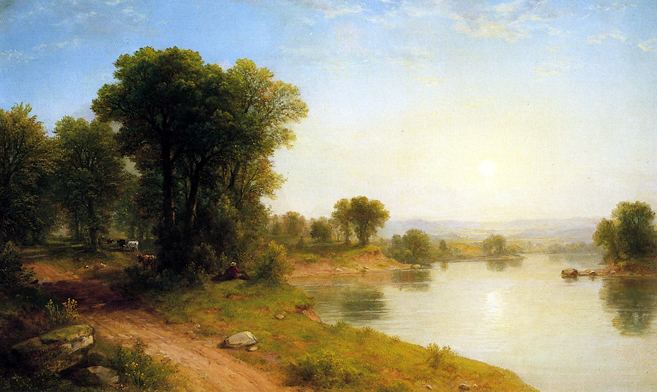
Landscape: 1866
Asher B. Durand one of the greatest artists of Hudson River School
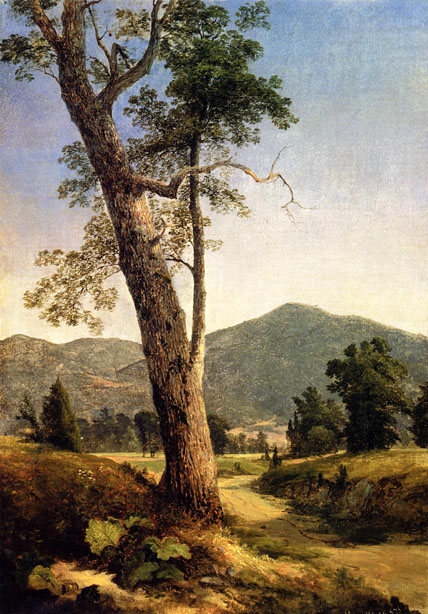
Landscape Beyond the Tree: 1859
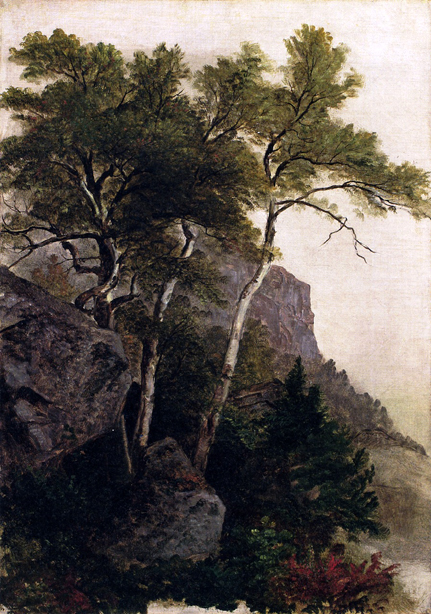
Landscape ca: 1855
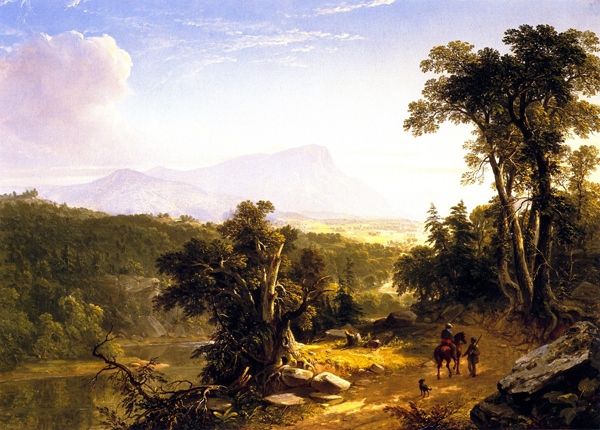
Landscape Composition: In the Catskills: 1848
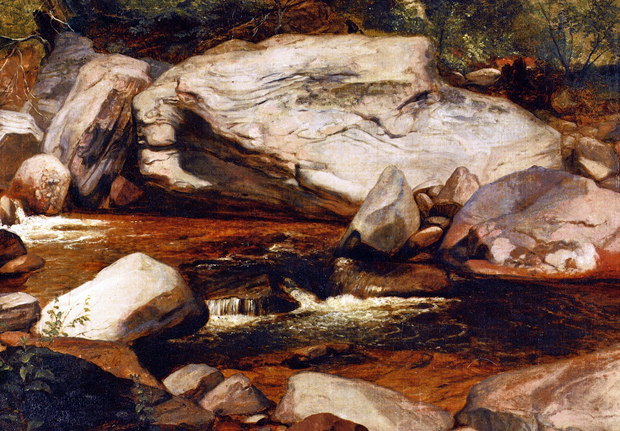
Landscape: Creek and Rocks: ca 1850-59

Landscape Scene from Thanatopsis: 1850
Contrary to the popular conception of Durand and even to his own preferences as an artist of natural scenery, he painted the occasional narrative or literary landscape in the manner of his mentor Thomas Cole well into the 1850s, several years after Cole's death. This synthetic prospect evidently illustrates "the great tomb of Man" which Durand's friend, the poet William Cullen Bryant, identified as humankind's earthly domain in one of his earliest and best known works, "Thanatopsis" (Greek for "meditation on death"). The poem embraces the cycle of life and death that both raises humankind, high-born and low, from insensible matter and returns him and her to it. Barely noticeable in the foreground grove takes place an actual burial, but the wider scene of forest, field, ploughman, shepherd, mountain, and the river winding toward an infinite marine horizon betokens nature's persistent rhythms and may well hint at the deceased's eternal reward.
Quoted From: Asher B. Durand: Landscape-Scene from "Thanatopsis" The Metropolitan Museum of Art
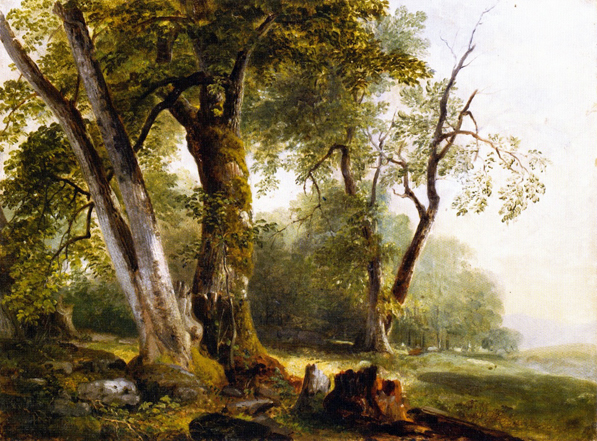
Landscape with Beech Trees: ca 1845
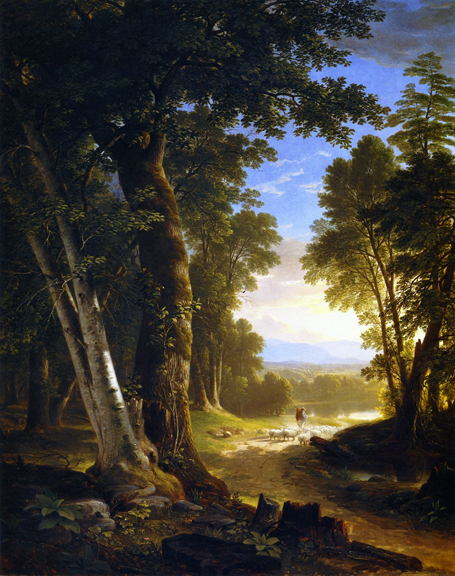
The Beeches: 1845
Initially titled "Landscape Composition," The Beeches originated in a plein-air study of beech and basswood trees that Durand made at an undetermined location probably not far from the banks of the Hudson River. Critics of the day distinguished the painting from the art of Durand's mentor, Thomas Cole, for its freedom from the narrative and allegorical freight that informed so many of Cole's pictures. In fact, the conception and vertical format of The Beeches distinctly reflect the suburban pastoral character and proportions of many works by the English master John Constable, whose paintings Durand had admired a few years earlier in London. Nonetheless, the warm, late-day glow of the prospect, suffusing the treetops at either side and highlighting the shepherd and his flock, resonates with the Italianate and French landscape antecedents that had marked most of Cole's production and would continue to affect Durand's work for several more years.
Quoted From: The Beeches - 1845 - The Metropolitan Museum of Art
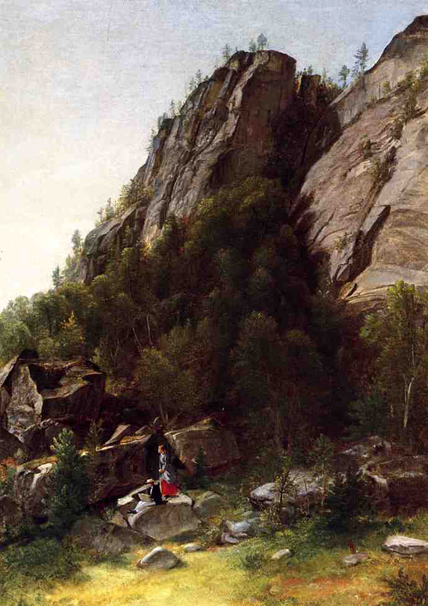
Landscape with Figures
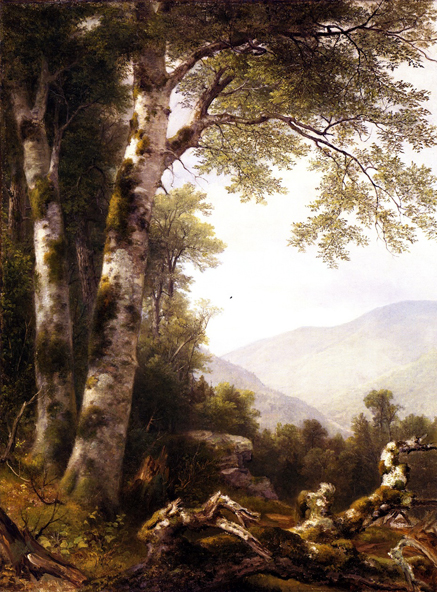
Landscape with Birches: ca 1855
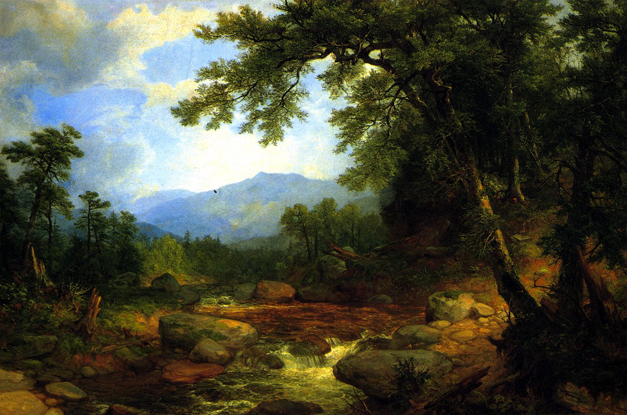
Monument Mountain, Berkshires: 1855-60

Mount Chocorua, New Hampshire: 1827
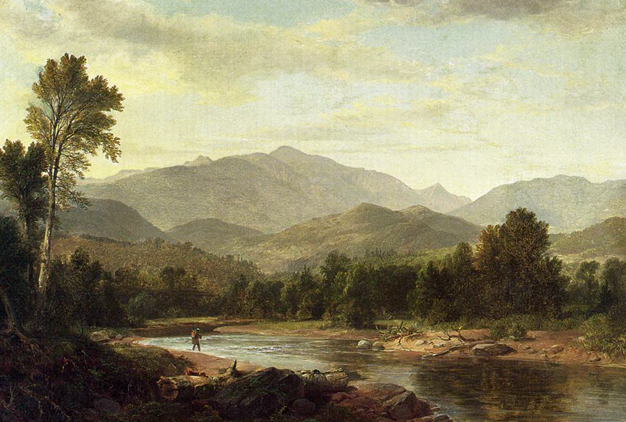
Mount Washington: 1855
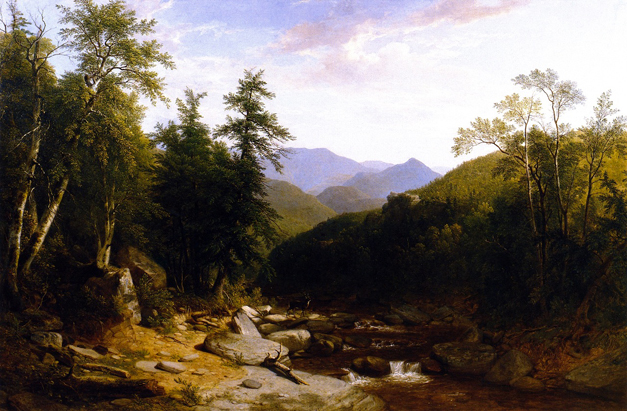
Mountain Stream: ca 1848
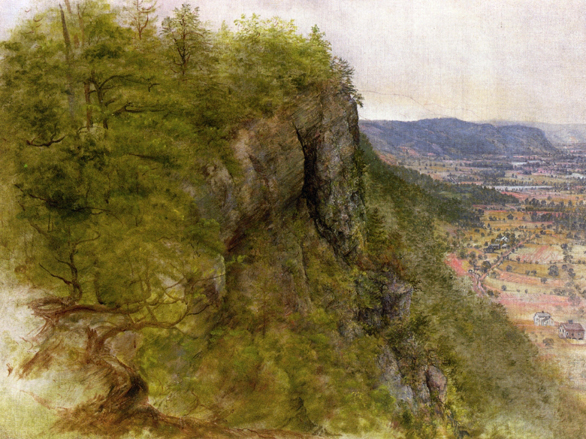
Mountain Vista: Date Unknown
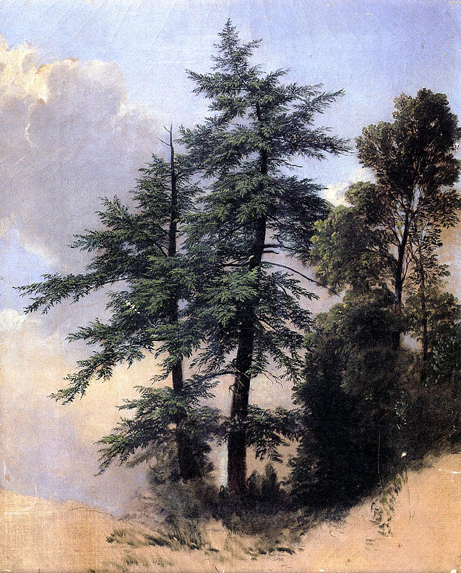
Nature Study, Trees, Newburgh, N.Y. - 1849

Nature Study: A Birch Tree - ca 1860
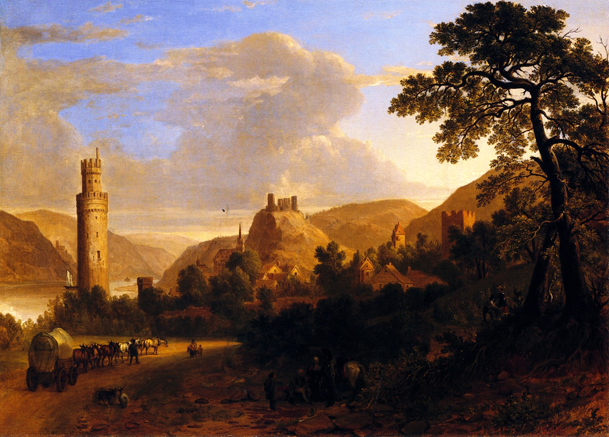
Oerwesel on the Rhine: 1843
Asher B. Durand was over 30 years old and the leading commercial engraver in the United States when he decided to become a painter. Accompanied by two other beginning American painters Durand traveled to Europe in 1840 to learn about high art.
This painting of a German town, Oberwesel on the Rhine, resulted from that grand tour. Durand was later to argue that American artists should not bother to paint European scenery or to clutter up nature with historic ruins. He encouraged American artists to get their inspiration directly from the nature of their own experience, the American wilderness. Durand was a major painter in what became known as the Hudson River School.
Quoted From: Wichita Art Museum
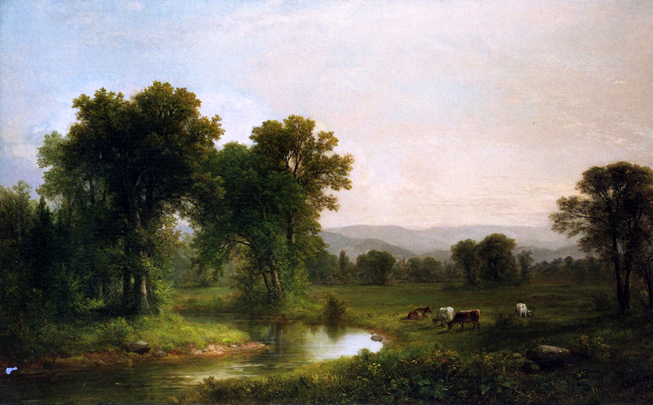
Pastoral Landscape: 1866
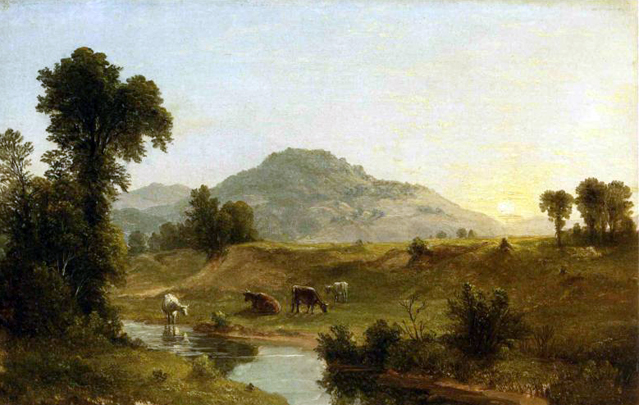
Pastoral Landscape: Date Unknown
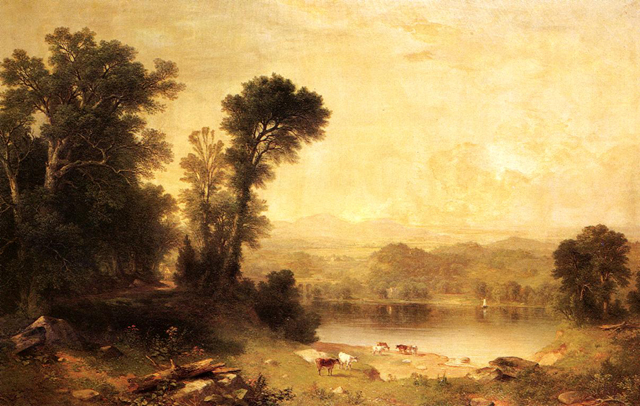
Pastoral Scene: 1861
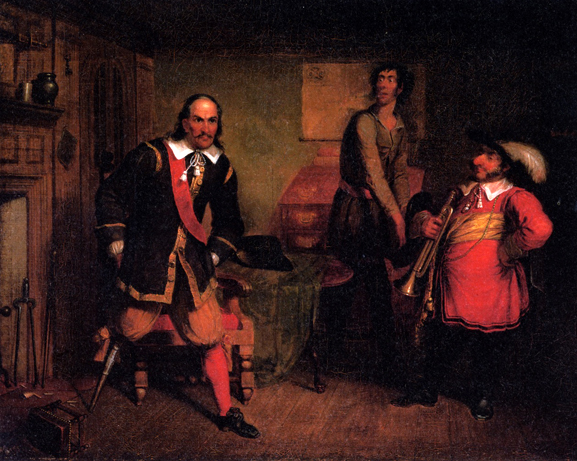
Peter Stuyvesand and the Trumpeter: 1836

Picnic in the Country: 1863
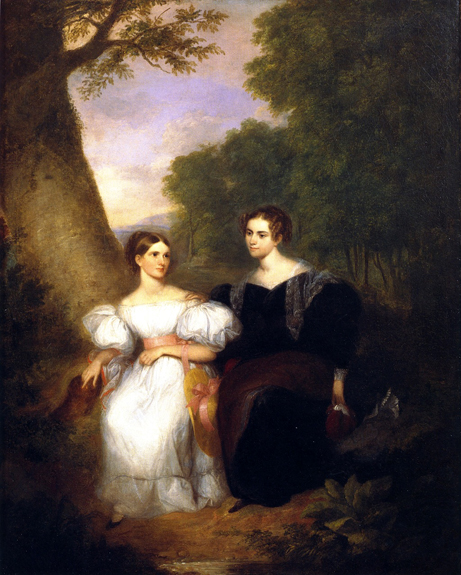
Portrait of the Artist's Wife and her Sister: 1834
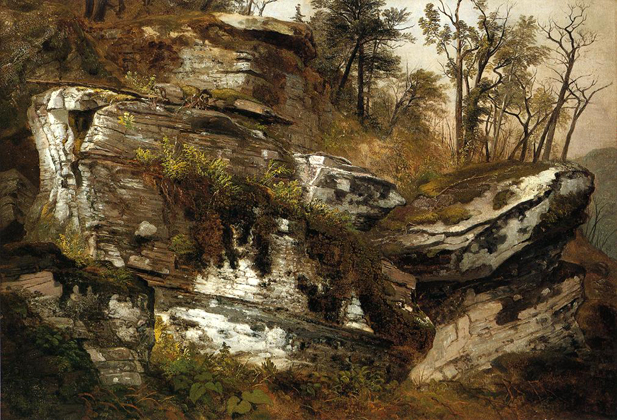
Rocky Cliff: ca 1860
One of the leaders of 19th-century landscape painting in America, Asher B. Durand shared with his fellow Hudson River artists a love of nature and a sense of pride in the new country's natural resources. His early works are typical in style to those of Thomas Cole and Frederic Church: large canvases that showcase panoramic views of the American landscape. Durand also excelled, however, at closely-observed studies of native flora and fauna. Trained as an engraver, the artist relished the almost scientific precision of these smaller-scale works. In Rocky Cliff, Durand trades the sky and misty mountain backgrounds of traditional Hudson River scenes for a close-up view of a wild lichen-covered outcropping topped by gnarled, twisted trees. The artist, however, communicates his wonder at the beauty and natural diversity of the scene just as easily with this intimate work as he had with earlier landscapes on a grander scale.
Quoted From: Reynolda House, Museum of Art
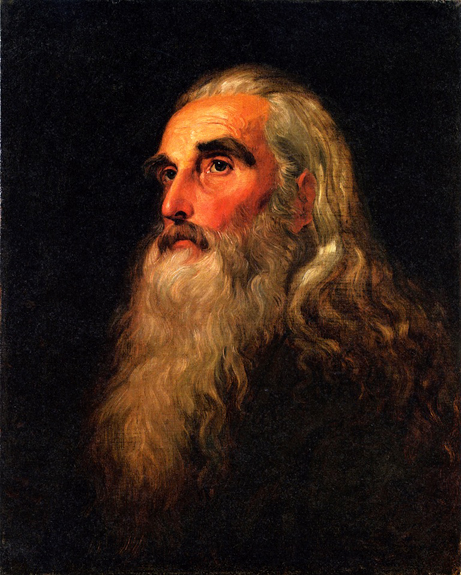
Roman Head: 1840
This painting along with Durand's other "Head of a Roman" paintings were exhibited at the National Academy in 1842. This is one of eight studies of elderly Roman men painted by Durand in 1840-41, of which the society owns four.
Quoted From: Roman Head - New York Historical Society

Roman Head: ca 1840-41
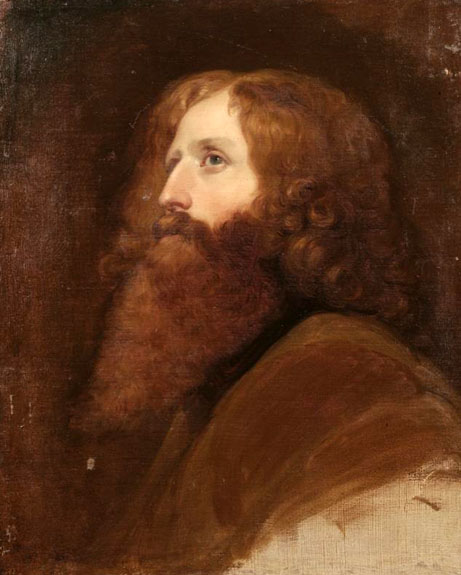
Roman Head: ca 1840-41
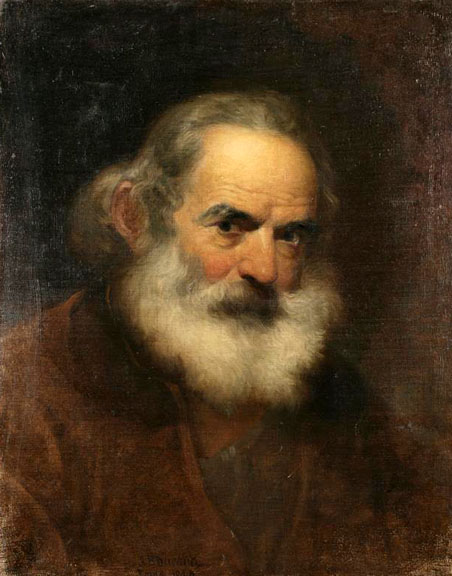
Roman Head: ca 1840-41
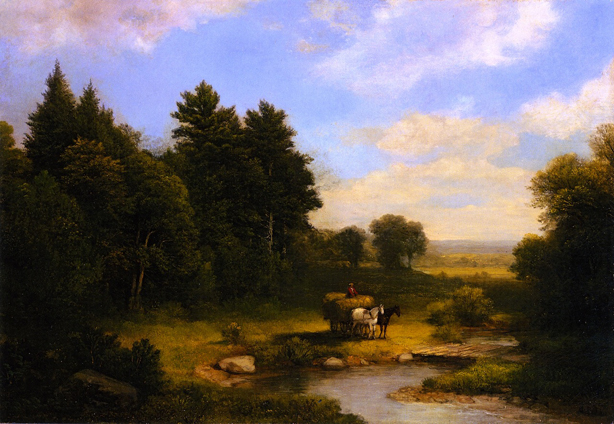
Rural Landscape with Hay Wagon: ca 1860
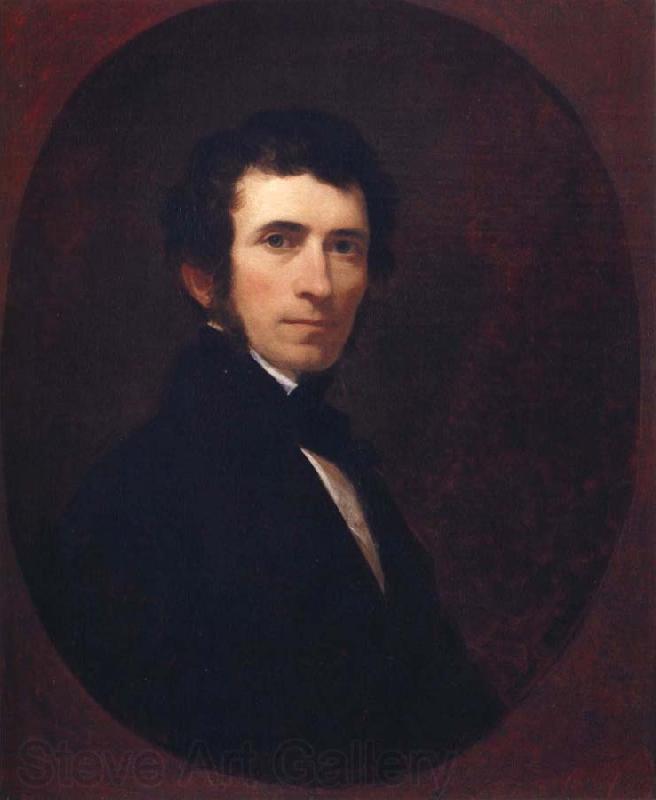
Self-Portrait
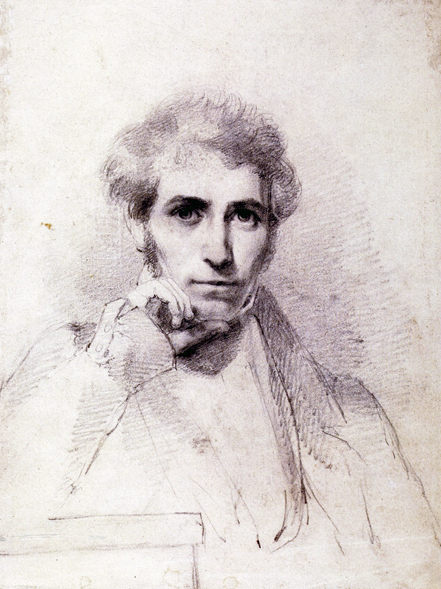
Self Portrait: ca 1830-33
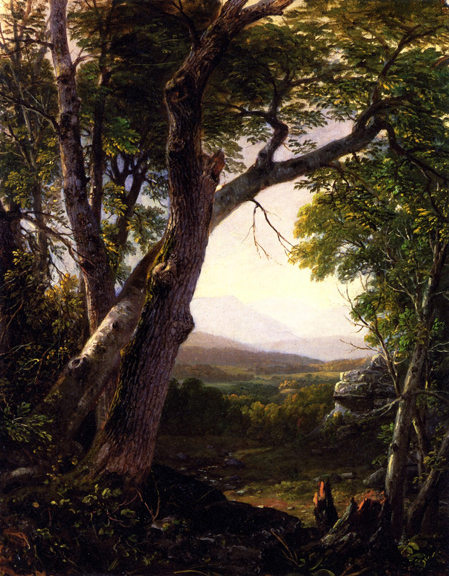
Shandaken Range, Kingston: ca 1854
Durand modeled the trees in the foreground of a Landscape signed and dated 1855, now owned by the Toledo Museum of Art, after the trees in this study.
Quoted From: Shandaken Range, Kingston, New York - New York Historical Society
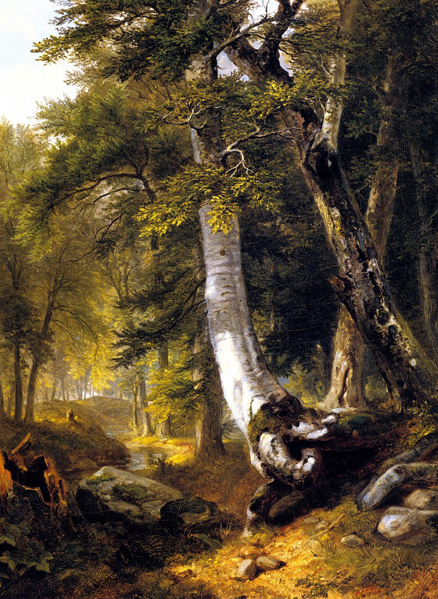
Sketch in the Woods: ca 1854
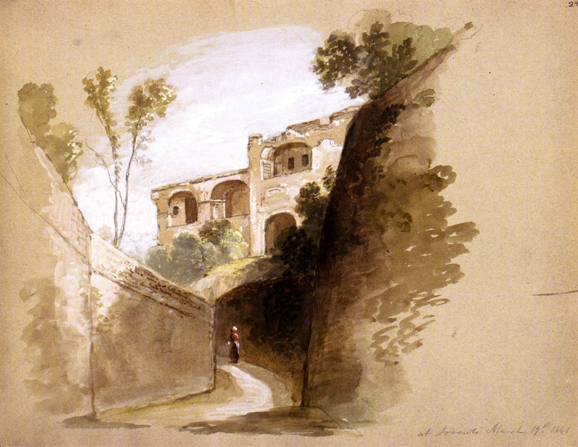
Sorrento: 1841
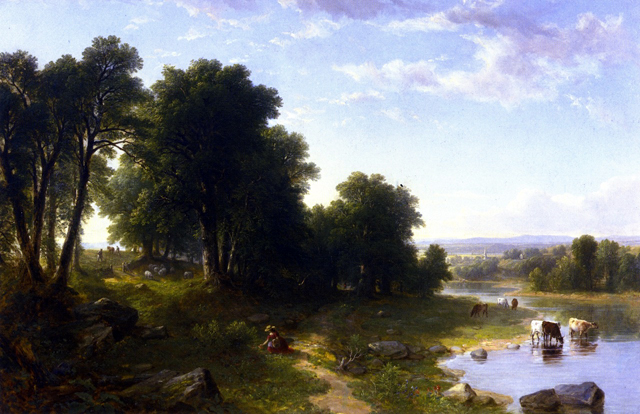
Strawberrying: 1854
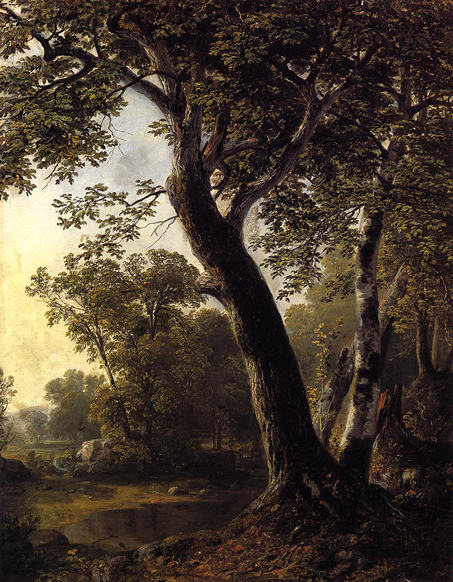
Study at Marbletown, Ulster County: ca 1845
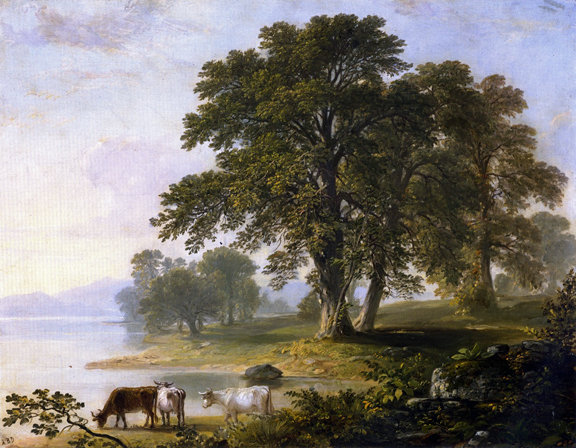
Study for a Summer Afternoon: ca 1865
Commissioned by Morris K. Jesup, the powerful railroad banker and first president of the American Museum of Natural History, Summer Afternoon reflects the taste of many of Durand's wealthy patrons, less for the naturalistic American woodland scenes he perfected, than for classic prospects. This one directs the eyes downstream at left to the lowering sun, which is set off spatially by the three grand elms at right sheltering a few cows that accessorize the middle distance. More generic than any of the other American landscapes in the Jesup collection, which was bequeathed to the Metropolitan in 1914, Summer Afternoon is nonetheless consistent with those other Jesup "chestnuts" of Hudson River School art: John Kensett's Lake George, Sanford Gifford's Gorge in the Mountains (Kauterskill Clove), Thomas Cole's Mountain Ford, Frederic Church's Parthenon, and Durand's own Beeches.
Quoted From: Summer Afternoon - The Metropolitan Museum of Art
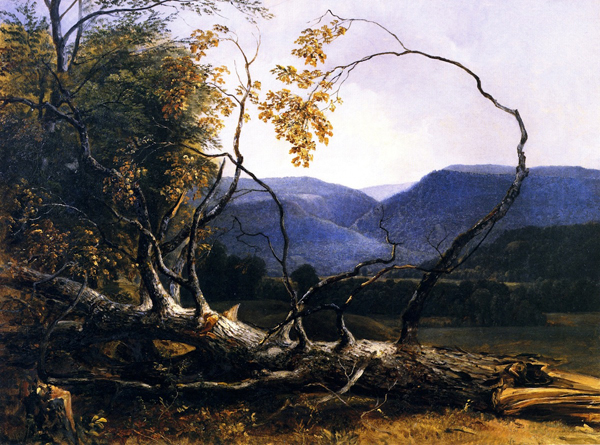
Study from Nature, Stratton Notch, Vermont: 1853
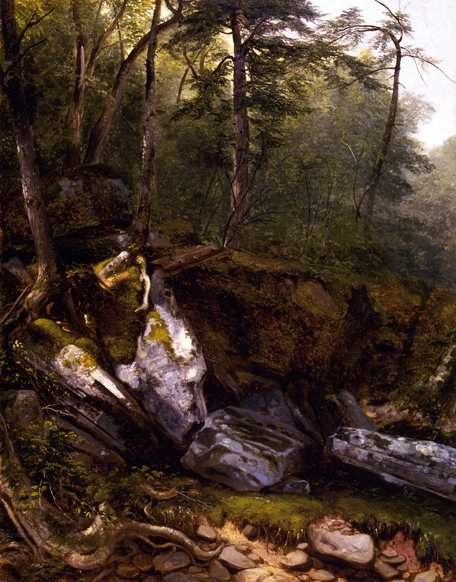
Study from Nature Rocks and Trees in the Catskills, New York: ca 1856
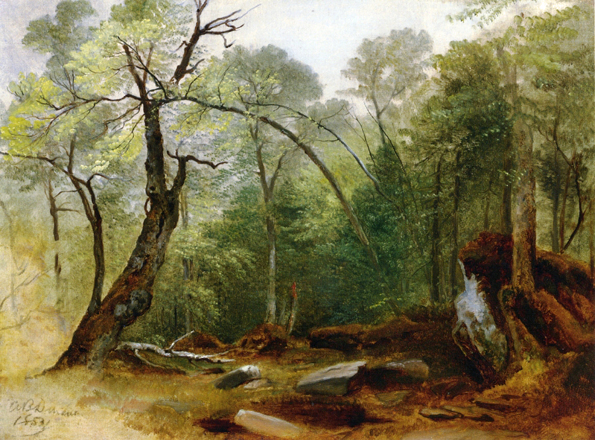
Study in the Woods: 1853
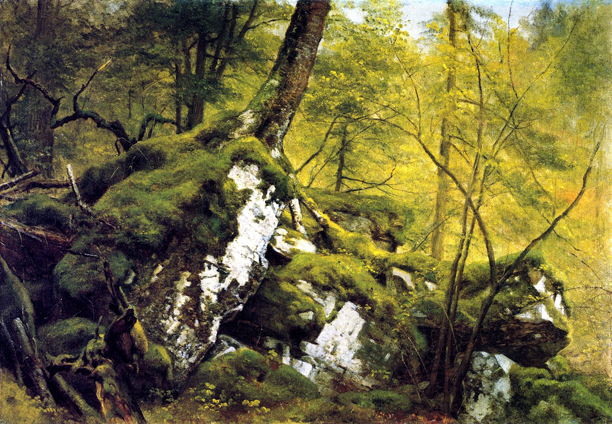
Study of a Wood Interior: ca 1850
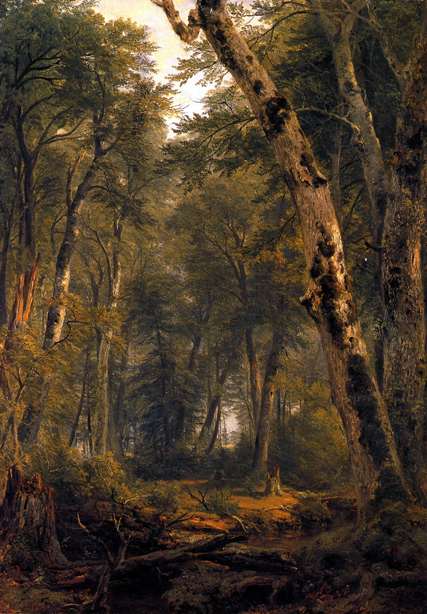
Woodland Interior: ca 1854
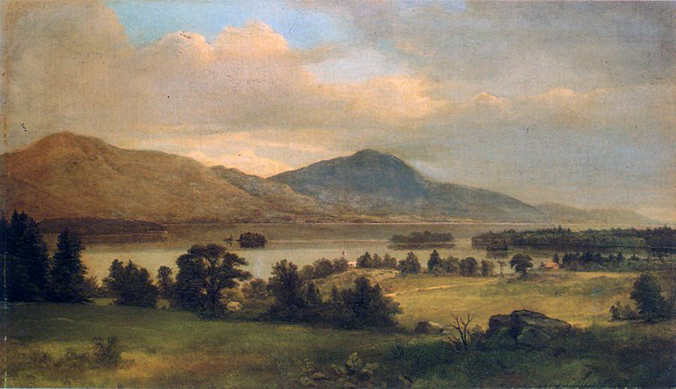
Summer on Lake George: Date Unknown
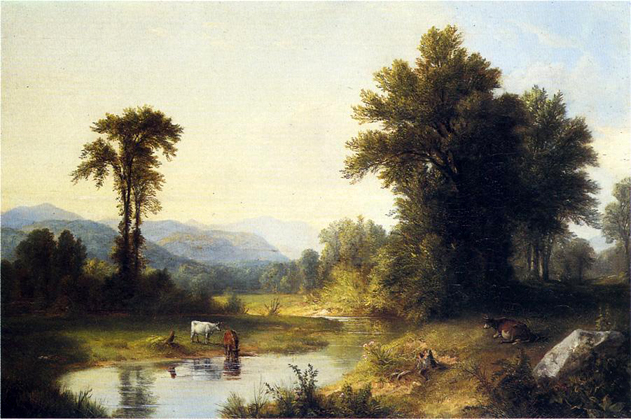
Summer Stream: 1858
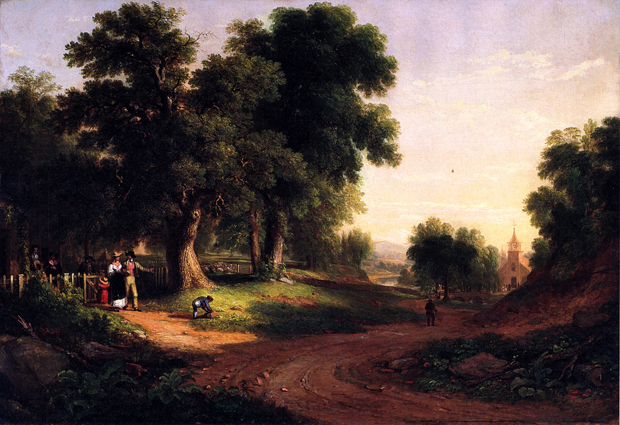
Sunday Morning: ca 1839
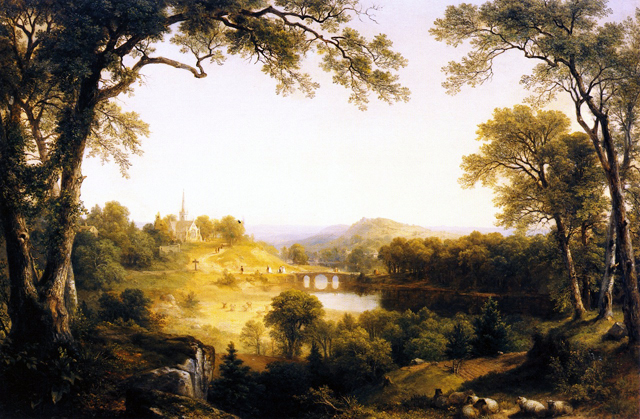
Sunday Morning: 1860
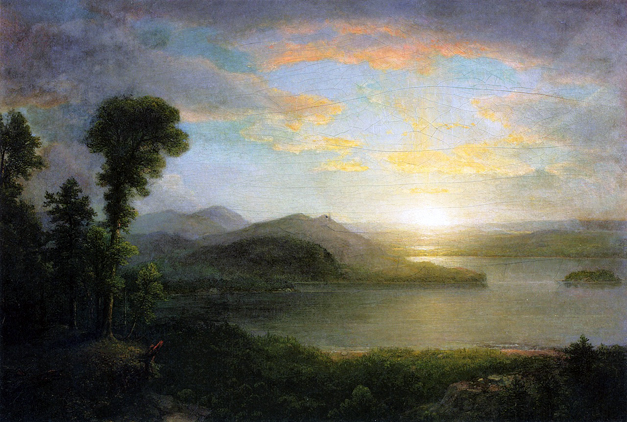
Sunset Souvenir of the Adirondacks: 1878
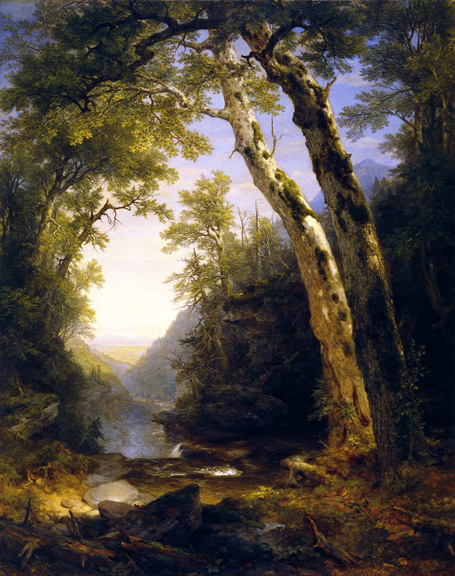
The Catskills: 1859
This painting was commissioned by William T. Walters in 1858, when the 62-year-old Durand was at the height of his fame and technical skill. The vertical format of the composition was a trademark of the artist, allowing him to exploit the grandeur of the sycamore trees as a means of framing the expansive landscape beyond. Durand's approach to the "sublime landscape" was modeled on that of Thomas Cole (1801-48), founder of the Hudson River school of painting. The painters of this school explored the countryside of the eastern United States, particularly the Adirondack Mountains and the Catskills. Their paintings often reflect the Transcendental philosophy of Ralph Waldo Emerson (1803-82), who believed that all of nature bore testimony to a spiritual truth that could be understood through personal intuition.
Quoted From: The Catskills - The Walters Art Museum
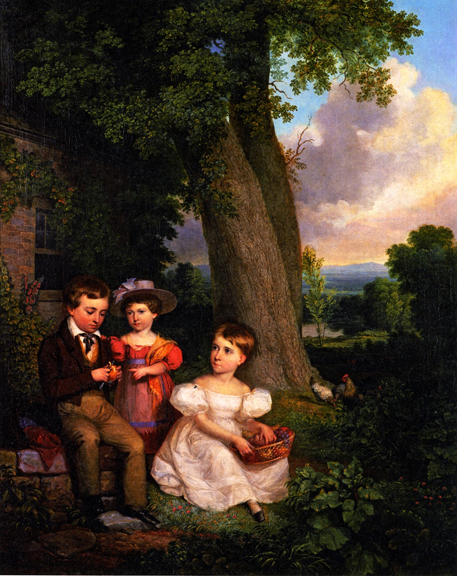
The Durand Children: 1832
John, Caroline, and Lucy M. Durand were the children of Asher B. Durand and his first wife, Lucy (Baldwin) Durand. According to a letter in the Durand Papers (Manuscript Division, New York Public Library), this group portrait was painted in the summer of 1832.
Quoted From: The Durand Children - New York Historical Society
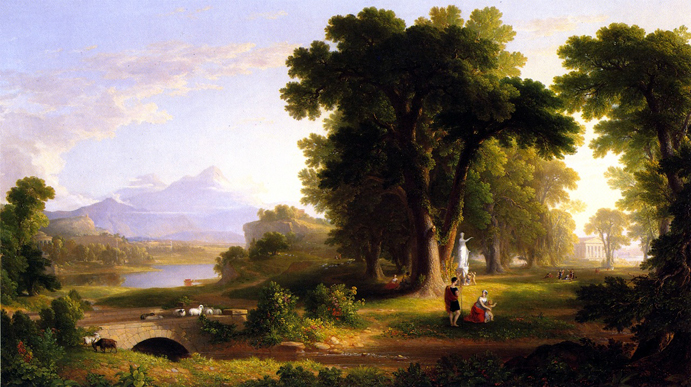
The Morning of Life: 1840
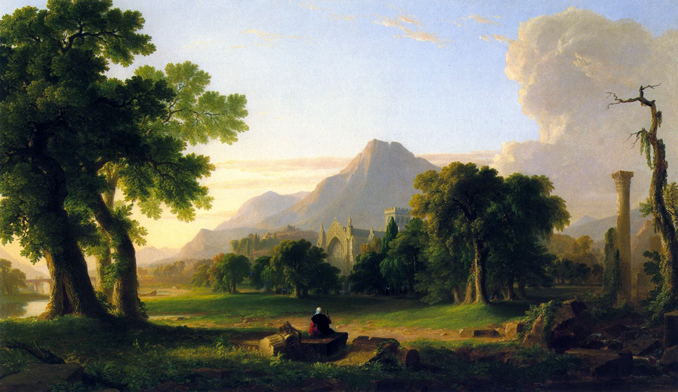
The Evening of Life: 1840
The National Academy Museum and School of Fine Arts
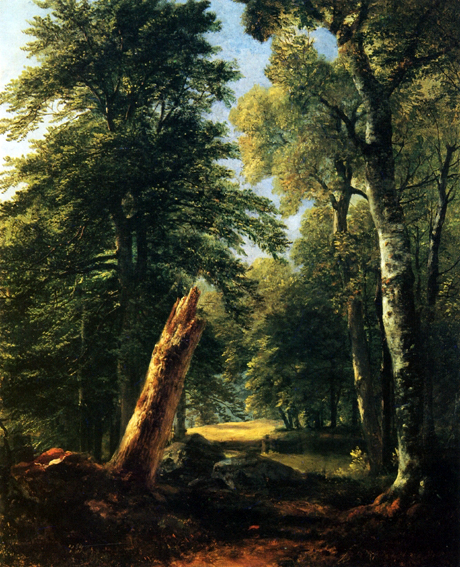
The Fallen Monarch: Date Unknown
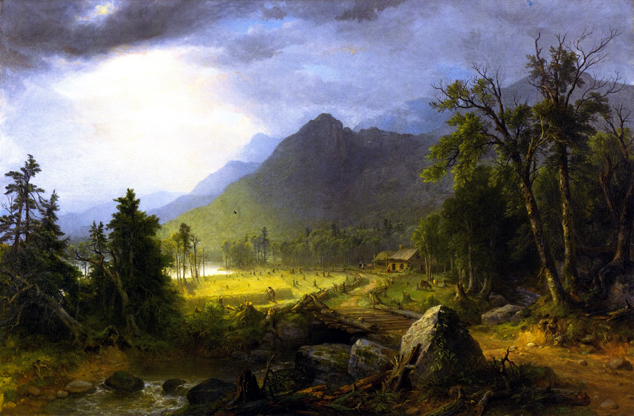
The First Harvest in the Wilderness: 1855
Asher B. Durand's composition depicts an expanse of rugged terrain and forests under stormy skies. This American wilderness yields to progress as a lone farmer reaps his first harvest in a field, still dotted with the stumps of recently cleared trees and gleaming under a sudden shaft of light that penetrates the heavy clouds. A boulder resting by the side of the road identifies our glorified pioneer by name as "Graham." Using funds bequeathed by one of its founders, Augustus Graham, the Museum commissioned Durand to paint this work in 1855, thus officially establishing its collection of American art. Durand's dramatic landscape pays tribute to Graham's efforts as a cultural pioneer.
Quoted From: Brooklyn Museum: American Art - The First Harvest in the Wilderness
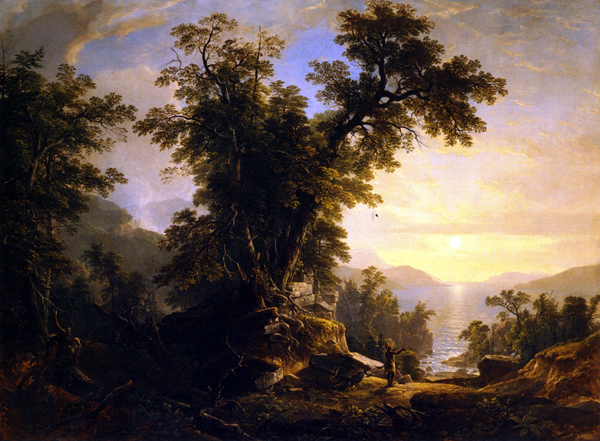
The Indians Vespers: 1847
Inside the White House - The White House Collection
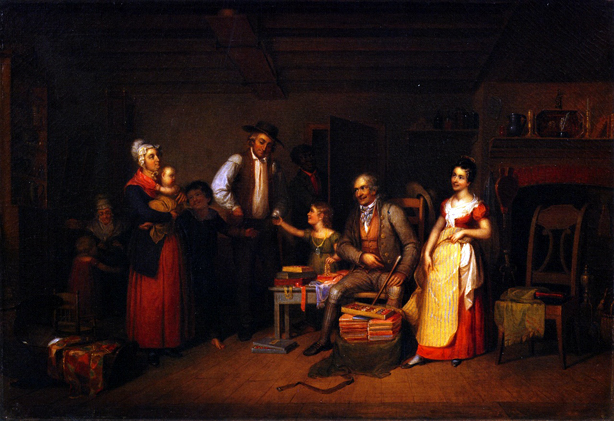
The Pedlar: 1836
This work was painted for Luman Reed of New York. In a letter to his son John Durand, February 14, 1836: Preparatory figure sketches for this painting are in Durand's sketchbook, 1835-1836, also in the Society's collection, and in a sketchbook owned by the Metropolitan Museum of Art, given by Miss Frederic F. Durand.
Quoted From: The Pedlar (The Pedlar Displaying His Wares) - New York Historical Society
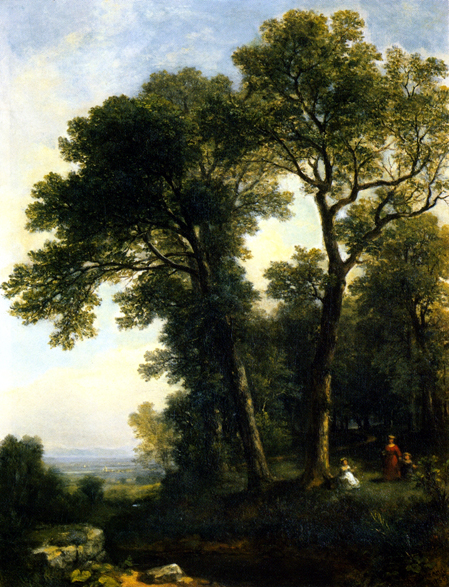
The Picnic: 1869

The Sketcher: 1870
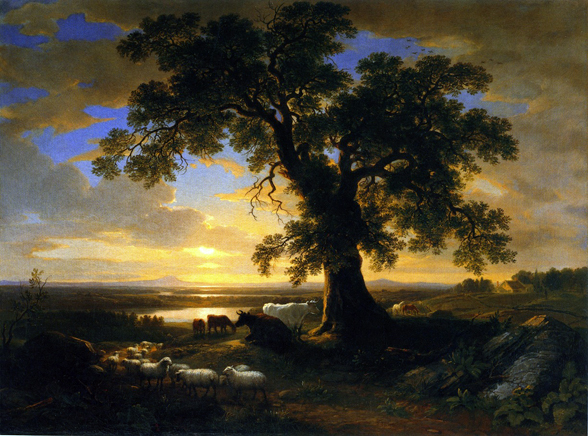
The Solitary Oak: 1844
Durand's original title for this painting was The Solitary Oak with the Old oak listed as a later designation.
Quoted From: The Solitary Oak (The Old Oak) - New York Historical Society
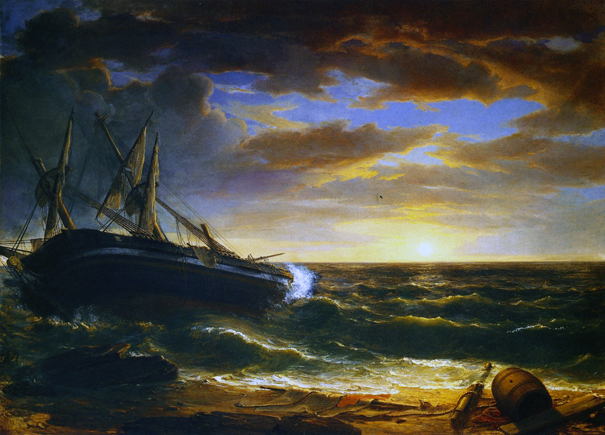
The Stranded Ship: 1844
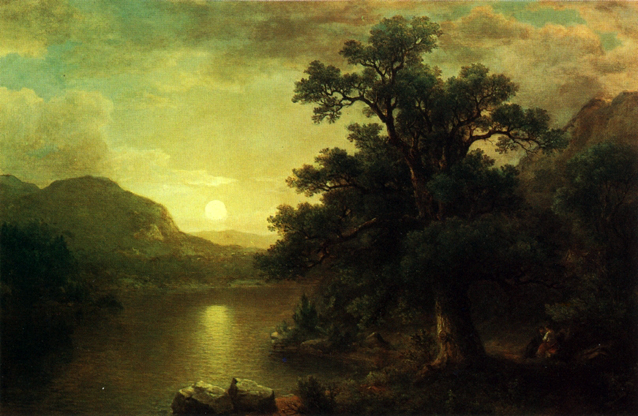
The Trysting Tree: 1868
Butler University - The Trysting Tree: 1868
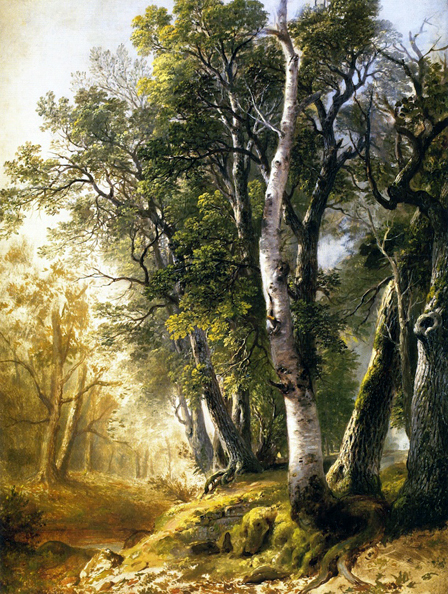
Trees by the Brookside, Kingston, New York: ca 1846

View in the Catskills: 1844
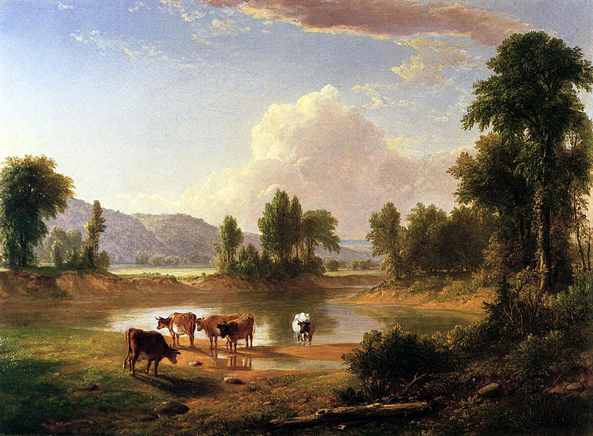
View of Esopus Creek, Ulster County, New York: Date Unknown
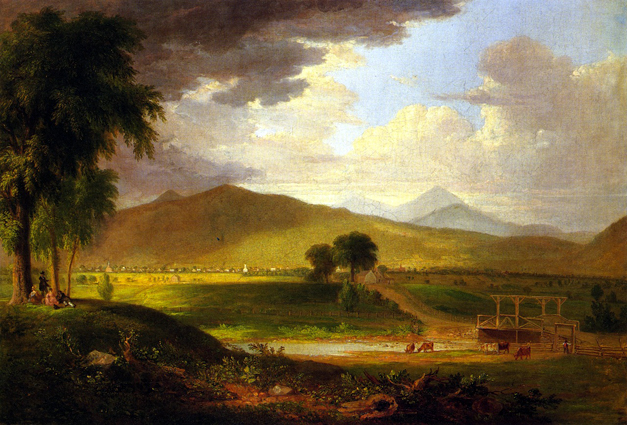
View of Rutland, Vermont: ca 1839-40
Louvre, High, Crystal Bridges, and Terra Foundation Launch Multi-Year Collaboration Devoted to American Art
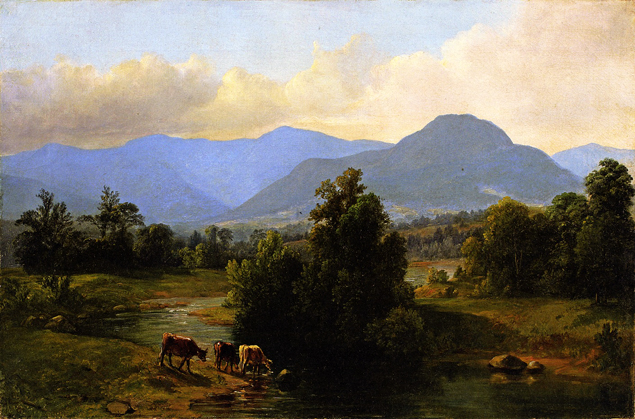
View of the Shandaken Mountains, New York: 1853
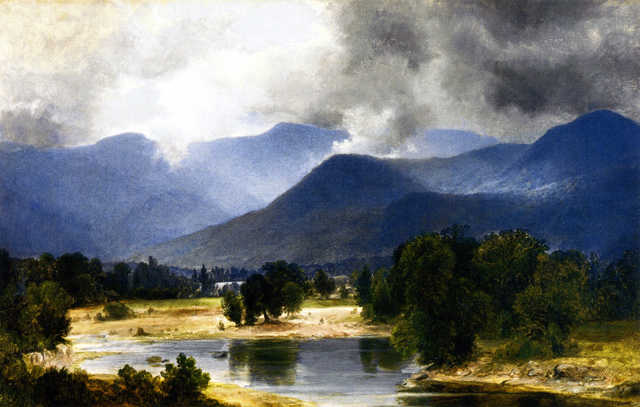
View of the Shandaken Mountains: 1853
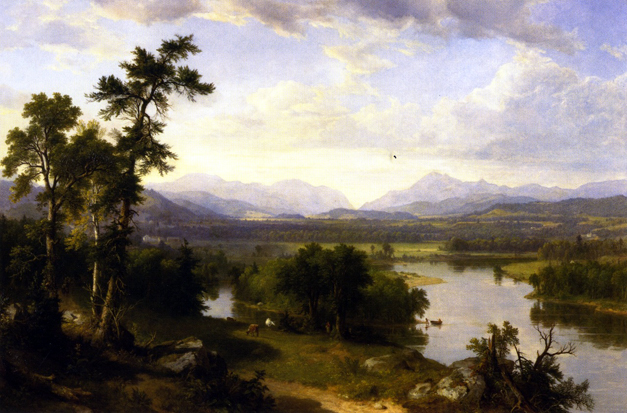
White Mountains Scenery, Franconia Notch, New Hampshire: 1857
American Landscape Paintings from the Hudson River School
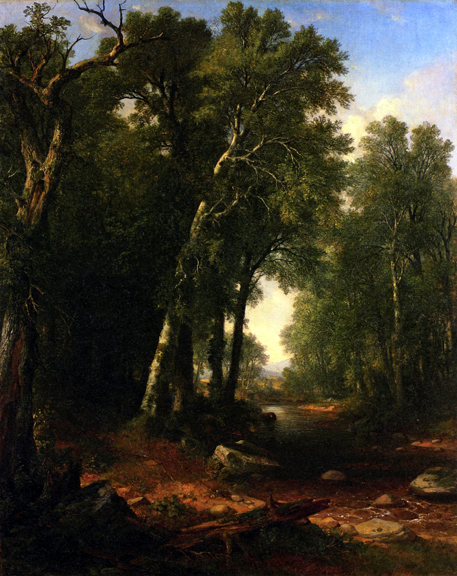
Woodland Brook: 1859
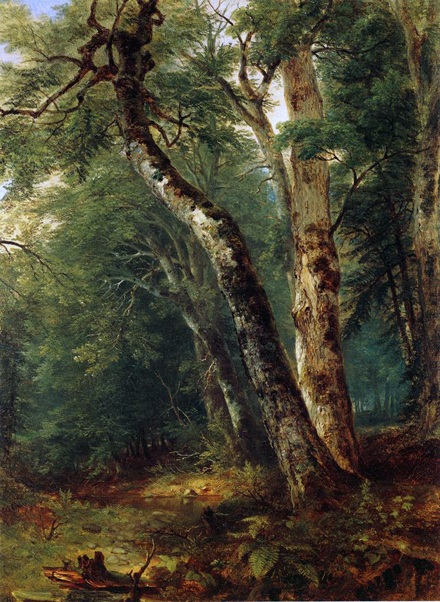
Woodland Interior: ca 1855
AMERICAN SCENERY: DIFFERENT VIEWS IN HUDSON RIVER SCHOOL PAINTING
On Loan from Westmoreland Museum of Art
American Scenery features landscape paintings grouped by pairs or arranged in series so the viewer can see how different generations of Hudson River School artists interpreted the majestic American landscape. The Hudson River School, considered by many to be the first truly American school of painting, flourished between 1825 and 1875. The three generations of artists (71 in all) represented in the exhibition of 114 paintings are assembled from one private collection. According to Judith O'Toole, director of the Westmoreland Museum, "American Scenery's themes of changing seasons, times of day, and weather conditions, inspired artists to create different views. The artists of the Hudson River School shared an interest in portraying different views of the untamed American landscape as reflection of our unique national character, and as a way of communicating universal truths and philosophical concepts."
Quoted From: The Everhart Museum of Natural History
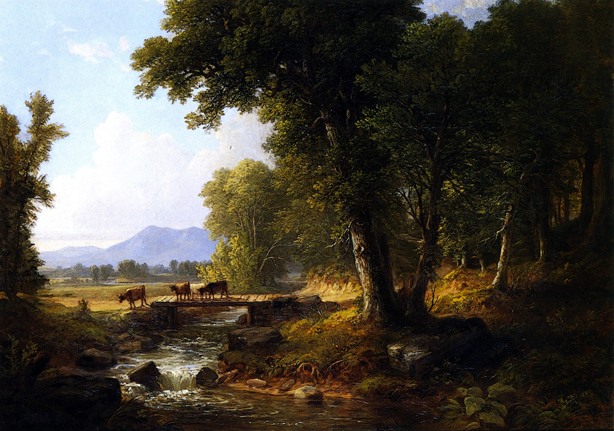
Woodland Landscape: 1854

Woodland Scene: ca 1850
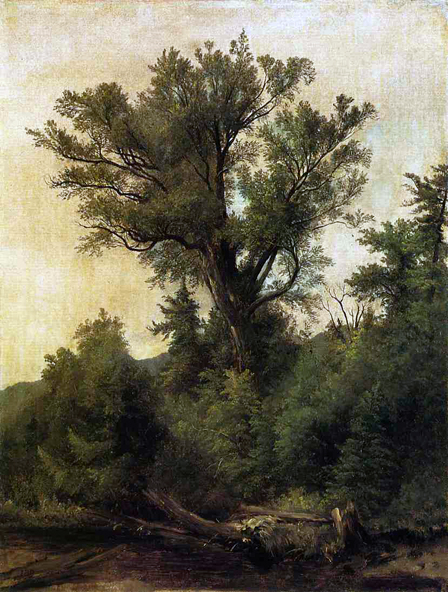
Woodland Stream: Date Unknown
Related Source Material:
Asher B. Durand - The Athenaeum
Asher Brown Durand - Wikipedia
Asher B. Durand Online
The Hudson River School
This page is the work of Senex Magister
Return to Pagina Artis
Return to Bruce and Bobbie's Main Page.
































































































































